Archived Blog Posts
Sometimes The Worst Part Of The Fire Is The Smoke
6/7/2024 (Permalink)
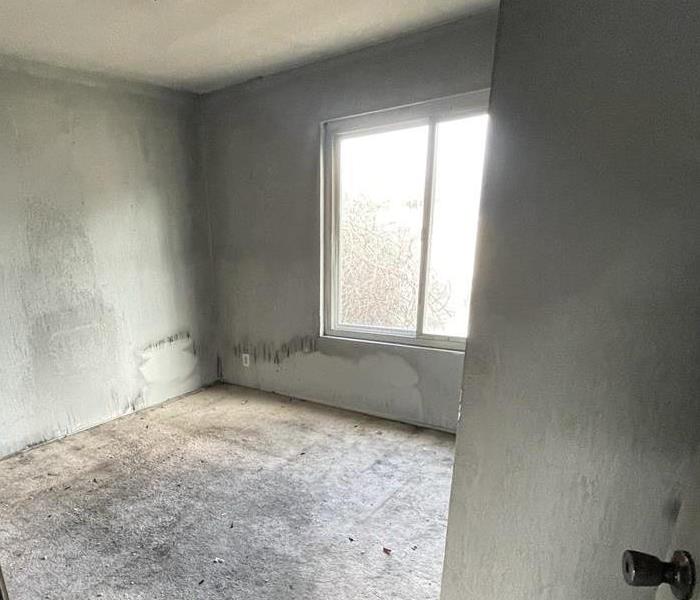 Even though the fire happened downstairs in the kitchen, soot and smoke filled the upstairs bedrooms.
Even though the fire happened downstairs in the kitchen, soot and smoke filled the upstairs bedrooms.
After a small fire in your house, SERVPRO® can provide comprehensive services to address soot and smoke damage. Here’s how we can help:
1. Assessment and Inspection
SERVPRO professionals will start with a thorough inspection of the property to assess the extent of soot and smoke damage. They use advanced equipment and techniques to determine how far the smoke has penetrated walls, furniture, and other surfaces.
2. Immediate Board-Up Service
If the fire has compromised windows, walls, or the roof, SERVPRO can provide immediate board-up to protect your home from further damage, weather exposure, and security breaches.
3. Soot and Smoke Removal
SERVPRO uses specialized equipment and techniques to remove soot from surfaces such as walls, ceilings, and furniture. This includes:
-Dry Cleaning: For light soot residue.
- Wet Cleaning: For moderate to heavy soot residue.
- Spray and Wipe: For items that cannot withstand wet cleaning.
-
Foam Cleaning: For upholstery fabrics.
- Abrasive Cleaning: For tough residues.
4. Odor Removal
SERVPRO employs various methods to eliminate smoke odor from your home, including:
- Air Scrubbers: These machines use HEPA filters to remove airborne particles and odors.
- Thermal Fogging: This process neutralizes odor-causing particles by releasing a dense fog of deodorizing compounds.
- Ozone Treatment: Ozone generators break down odor molecules at a molecular level.
- Hydroxyl Generators: These generate hydroxyl radicals that safely eliminate odors.
5. Cleaning and Sanitizing
They will clean and sanitize all restorable items and structures that were damaged by the fire. This includes:
- Carpet and Upholstery Cleaning: Professional deep-cleaning methods to remove soot and smoke residues.
- Duct Cleaning: To remove soot and odor from the HVAC system and ductwork.
- Contents Cleaning: Items such as clothing, linens, and personal belongings can be cleaned and deodorized.
6. Reconstruction Services
If the fire damage requires significant repairs or reconstruction, SERVPRO can handle the reconstruction process. They offer a range of construction services, including drywall installation, painting, and flooring repair or replacement.
7. Insurance Assistance
SERVPRO can also assist with the insurance claims process, providing detailed documentation of the damage and the restoration work performed. They can work directly with your insurance company to expedite the claims process and ensure that you receive the coverage you’re entitled to.
Benefits of Choosing SERVPRO
- Expertise and Experience: With years of experience, SERVPRO technicians are highly trained in dealing with fire and smoke damage.
- Advanced Technology: They use state-of-the-art equipment and techniques to ensure thorough cleaning and restoration.
- 24/7 Emergency Service: SERVPRO is available around the clock to respond to emergencies, minimizing the damage and beginning the restoration process promptly.
- Comprehensive Service: From initial damage assessment to final reconstruction, SERVPRO provides end-to-end services, ensuring a seamless and efficient restoration process.
By choosing SERVPRO, you can be confident that your home will be restored to its pre-fire condition, free from soot, smoke residues, and odors, allowing you to return to a safe and clean living environment.
Refresh Your Home or Office This Spring
5/28/2024 (Permalink)
When disaster strikes, from water and fire damage to mold infestations, you need a reliable partner to restore your property to its original condition. For years, SERVPRO® has been that trusted ally, offering industry-leading restoration services to homeowners and businesses alike. But did you know that we also provide top-notch painting services? That's right! Beyond restoring your property, we can help you reimagine and rejuvenate your space with our professional painting services.
Why Choose SERVPRO for Painting Services?
1. Comprehensive Expertise:
Our team comprises skilled professionals who are not only experts in restoration but also in the fine art of painting. Whether it's a small room or an entire building, we bring the same level of dedication and precision to our painting projects as we do to our restoration work.
2. Quality Materials and Techniques:
We use high-quality paints and the latest techniques to ensure a flawless finish. Our commitment to excellence means that your walls will not only look stunning but also stand the test of time.
3. Seamless Integration with Restoration Work:
If your property has suffered damage, our dual expertise in restoration and painting ensures a seamless transition from repair to beautification. We handle everything from drywall repair to the final coat of paint, making the process smooth and stress-free for you.
4. Customized Solutions:
We understand that every space is unique. Our team works closely with you to select colors and finishes that reflect your style and enhance the overall ambiance of your property. Whether you prefer bold, vibrant colors or soft, soothing tones, we tailor our services to meet your specific needs.
5. Professionalism and Cleanliness:
We pride ourselves on our professionalism and respect for your property. Our team takes great care to protect your furniture and floors, ensuring a clean and tidy work environment. We complete the job with minimal disruption to your daily life.
Our Painting Services Include:
- Interior Painting: Refresh the look of your home or office with our expert interior painting services. From walls and ceilings to trim and doors, we handle every detail with precision.
- Exterior Painting: Enhance your property's curb appeal with our high-quality exterior painting services. We ensure your building looks its best and is protected from the elements.
- Commercial Painting: Create a welcoming and professional environment for your business with our commercial painting services. We work around your schedule to minimize downtime and ensure a flawless finish.
- Specialty Coatings: From textured finishes to specialty coatings, we offer a range of options to give your space a unique and personalized touch.
The SERVPRO Difference
At SERVPRO, we are more than just a restoration company. We are your partners in transforming your property into a space you love. Our dual expertise in restoration and painting allows us to provide comprehensive services that save you time and hassle. Trust us to bring your vision to life with our exceptional painting services, backed by the reliability and reputation of SERVPRO.
SERVPRO® Reconstruction
4/19/2024 (Permalink)
We're thrilled to announce a significant enhancement to our suite of services here at SERVPRO. As a leader in the restoration industry, we have continually strived to meet the evolving needs of our customers, and today, we're excited to unveil a major development: SERVPRO® now offers full reconstruction services alongside our renowned restoration work.
This expansion represents a natural progression for us, born out of a deep commitment to providing comprehensive solutions to our customers during times of crisis. While our restoration services have long been trusted to swiftly mitigate damage and restore properties to their preloss condition, we recognize that in some cases, the scope of damage requires more than just restoration – it demands reconstruction.
With our new full reconstruction services, we can seamlessly transition from the initial cleanup and restoration phase to the rebuilding process, offering a streamlined and hassle-free experience for our customers. Whether it's repairing structural damage, rebuilding walls, or completely renovating a space, our experienced team is equipped with the skills, expertise, and resources necessary to handle projects of any size or complexity.
What sets SERVPRO apart is our unwavering commitment to excellence in every aspect of our work. Our reconstruction services adhere to the same high standards of quality, professionalism, and attention to detail that have become synonymous with the SERVPRO name. From the initial assessment to the final touches, we prioritize clear communication, transparency, and customer satisfaction every step of the way.
By expanding our services to include full reconstruction, we're empowering our customers to navigate the aftermath of disasters with confidence, knowing that SERVPRO is here to provide comprehensive support and solutions from start to finish. Whether you're dealing with fire damage, water damage, storm damage, or any other type of property loss, you can trust SERVPRO to deliver prompt, reliable, and expert care, now encompassing both restoration and reconstruction needs.
At SERVPRO, we understand that disasters don't wait – and neither do we. With our expanded range of services, we're more equipped than ever to respond swiftly and effectively to our customers' needs, helping them restore their properties and their peace of mind as quickly as possible.
If you're in need of restoration or reconstruction services, don't hesitate to contact SERVPRO today. Our team is standing by 24/7 to provide the assistance and support you need to overcome any challenge and rebuild stronger than ever before.
Fire Damage Repair
3/29/2024 (Permalink)
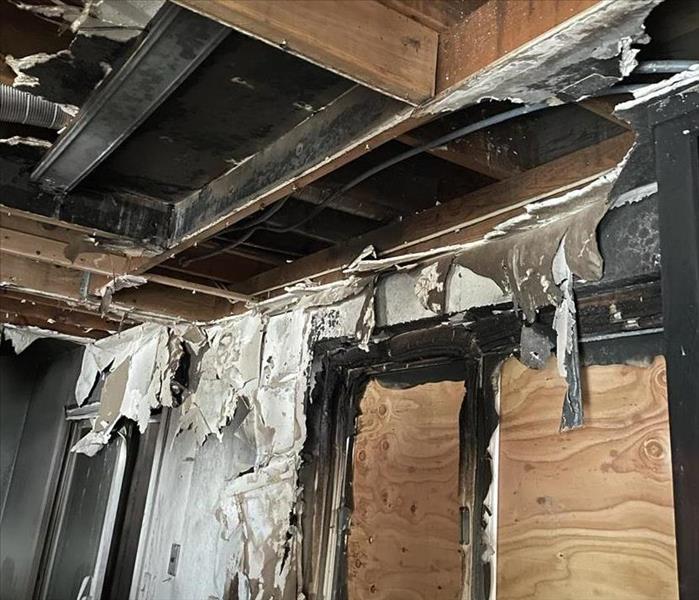 Cooking dinner turned into disaster with a grease fire.
Cooking dinner turned into disaster with a grease fire.
SERVPRO® is a well-known company that specializes in fire and water damage restoration. If you're dealing with fire damage hire SERVPRO for repairs, here's what you can typically expect:
1. **Assessment and Inspection**: thorough assessment of the fire damage to determine the extent of the damage and the best course of action for repair.
2. **Board-Up and Tarp Services**: If necessary, we will board up windows and doors and place tarps on damaged areas to secure your property and prevent further damage from weather or intruders.
3. **Water Removal and Drying**: Fire damage often involves water damage from firefighting efforts. SERVPRO will remove any standing water and thoroughly dry the affected areas to prevent mold and further structural damage.
4. **Smoke and Soot Removal**: Our professionals use specialized equipment and techniques to remove smoke and soot residue from surfaces, including walls, ceilings, and furniture.
5. **Cleaning and Sanitizing**: Once the smoke and soot are removed, SERVPRO will clean and sanitize the affected areas to eliminate odors and ensure a safe environment.
6. **Restoration and Reconstruction**: Depending on the severity of the fire damage, we may need to repair or replace structural elements, such as walls, floors, and ceilings. They can also handle cosmetic repairs, such as painting and replacing carpeting.
7. **Documentation and Communication**: Throughout the process, SERVPRO will keep you informed and provide documentation of the damage and the repairs being done. They can also work with your insurance company to streamline the claims process.
Overall, SERVPRO aims to restore your property to its pre-fire condition as quickly and efficiently as possible, minimizing disruption to your life and business. It's important to contact them as soon as possible after a fire to start the restoration process promptly.
How SERVPRO® Can Help With Storm Damage
2/26/2024 (Permalink)
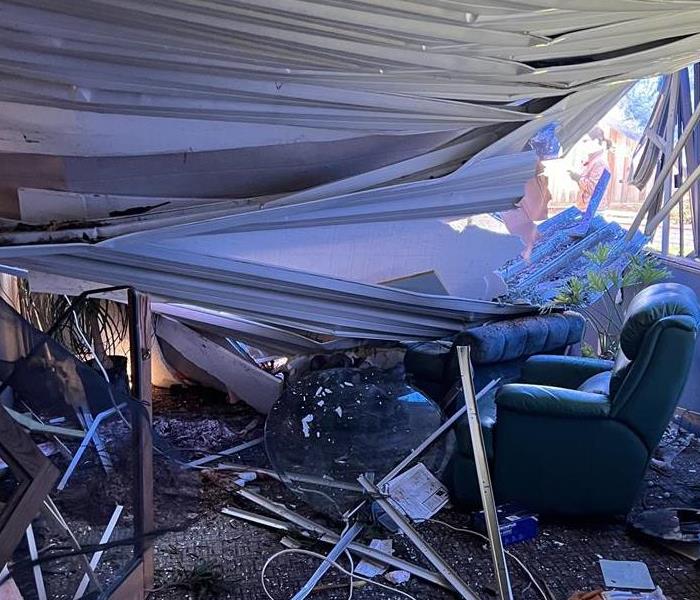 A house was severely damaged by recent storms.
A house was severely damaged by recent storms.
SERVPRO® is a company that specializes in disaster restoration and cleanup services, including those related to major storms and natural disasters. Here's how SERVPRO can help you after a major storm:
1. **Emergency Response:** SERVPRO offers 24/7 emergency response services. They understand the urgency of the situation after a major storm and can quickly deploy teams to assess the damage and begin the restoration process.
2. **Damage Assessment:** The first step involves a thorough assessment of the property to determine the extent of the damage. This includes identifying areas affected by water, wind, or other storm-related issues.
3. **Water Removal and Drying:** If the storm has caused flooding, SERVPRO has the equipment and expertise to remove standing water and thoroughly dry affected areas. This helps prevent further damage and reduces the risk of mold growth.
4. **Mold Remediation:** In the aftermath of a storm, mold can become a significant concern, especially if there's been water damage. SERVPRO can address mold issues through proper remediation techniques, including cleaning and sanitizing affected areas.
5. **Storm Damage Cleanup:** This involves the removal of debris, damaged materials, and any hazards left behind by the storm. SERVPRO ensures a safe and thorough cleanup process.
6. **Restoration Services:** Once the cleanup is complete, SERVPRO can start the restoration process. This may involve repairing or replacing damaged structures, flooring, walls, and other components to return the property to its pre-storm condition.
7. **Content Cleaning:** If personal belongings or contents have been damaged, SERVPRO offers content cleaning services. This includes cleaning, deodorizing, and restoring salvageable items.
8. **Insurance Coordination:** SERVPRO can work with your insurance company to streamline the claims process. They provide documentation of the damage and the restoration work done, helping you navigate the insurance claims process more efficiently.
9. **Building Services:** In addition to cleanup and restoration, SERVPRO provides building services. This may involve reconstruction, repairs, and other construction-related tasks to restore the property fully.
10. **Experience and Expertise:** SERVPRO has extensive experience in dealing with a variety of disasters, including major storms. Their trained and certified technicians use advanced equipment and follow industry best practices to ensure effective and efficient restoration services.
If you've experienced significant damage due to a major storm, contacting SERVPRO can help expedite the recovery process and minimize the long-term impact on your property.
SERVPRO® Can Save You From The Rain
2/2/2024 (Permalink)
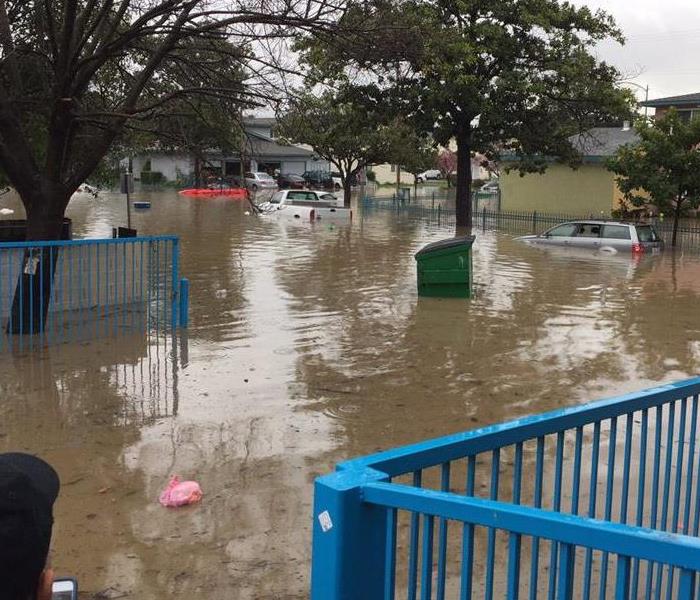 Heavy rains cause major damages in San Jose
Heavy rains cause major damages in San Jose
SERVPRO® is a professional restoration and cleaning service that can assist you in the event of rain-related damage to your property. Here are some ways in which SERVPRO® can help:
1. **Water Damage Restoration:**
- If your property experiences flooding or water damage due to heavy rain, SERVPRO® can provide water extraction services to remove standing water.
- They use advanced equipment such as pumps, dehumidifiers, and air movers to thoroughly dry the affected areas.
2. **Mold Remediation:**
- Excessive rain and moisture can lead to mold growth. SERVPRO® offers mold remediation services to assess and address any mold issues in your home or business.
3. **Storm Damage Cleanup:**
- Rainstorms can cause various types of damage, including roof leaks, broken windows, and structural damage. SERVPRO® can assist in cleaning up and repairing these damages.
4. **Document Drying:**
- If you have important documents or valuable items that are damaged by rainwater, SERVPRO® provides document drying services using specialized techniques to salvage and restore these items.
5. **Carpet and Upholstery Cleaning:**
- Rainwater can soil carpets and upholstery. SERVPRO® offers professional cleaning services to restore and refresh these items.
6. **Emergency Response:**
- SERVPRO® is available 24/7 for emergency response. If you experience rain-related damage, you can contact them, and they will dispatch a team promptly to assess the situation and begin the restoration process.
7. **Insurance Coordination:**
- SERVPRO® can work with your insurance company to streamline the claims process and ensure a smooth and efficient restoration experience.
It's important to note that the specific services offered may vary depending on the franchise location and the nature of the damage. If you are facing rain-related issues, contacting SERVPRO® office is advisable to discuss your specific needs and receive personalized assistance.
Emergency Water Clean Up
11/22/2023 (Permalink)
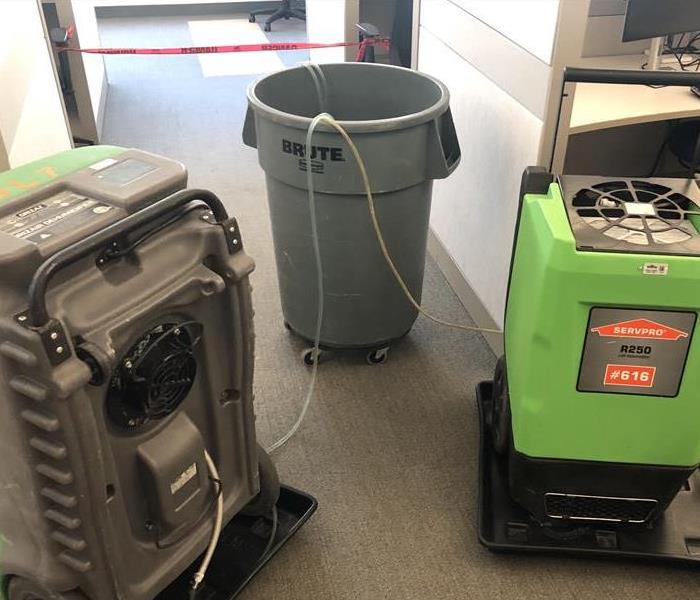 Professional grade equipment is used to dry out large, open spaces following a water leak in an office.
Professional grade equipment is used to dry out large, open spaces following a water leak in an office.
When it comes to drying out water damage, we follow a systematic process to ensure effective restoration. Here is a general overview of how SERVPRO® typically handles water damage:
1. **Emergency Contact:** The restoration process begins with a call to their emergency hotline. This allows them to gather information about the extent of the damage and dispatch a team to the site.
2. **Inspection and Damage Assessment:** Upon arrival, SERVPRO® technicians assess the extent of the water damage. This involves determining the category and classification of the water damage, which helps them create an appropriate plan for restoration.
3. **Water Removal:** The first step in drying out water damage is removing any standing water. SERVPRO® uses powerful pumps and vacuums to extract water from the affected areas. The sooner water is removed, the less damage is likely to occur.
4. **Drying and Dehumidification:** After standing water is removed, the drying process begins. Industrial-strength air movers and dehumidifiers are strategically placed to accelerate evaporation and reduce humidity. This step is crucial to prevent further damage such as mold growth.
5. **Cleaning and Sanitizing:** Once the affected areas are dry, SERVPRO® focuses on cleaning and sanitizing. This may involve cleaning carpets, upholstery, and other belongings. We also use specialized cleaning agents to disinfect and prevent microbial growth.
6. **Restoration:** The final step is restoration, which involves repairing or replacing damaged materials such as drywall, flooring, or structural components. The goal is to restore the property to its pre-damaged condition.
Throughout the entire process, SERVPRO® uses advanced monitoring equipment to track the moisture levels and ensure that the affected areas are drying properly. This helps prevent secondary damage and ensures the thoroughness of the restoration.
It's important to note that the specific steps may vary based on the unique circumstances of each water damage situation. SERVPRO® technicians are trained to adapt their approach based on the severity and type of water damage encountered. If you experience water damage, it's crucial to contact a professional restoration service promptly to mitigate the damage and prevent further issues.
How SERVPRO® Can Help Your Office
10/10/2023 (Permalink)
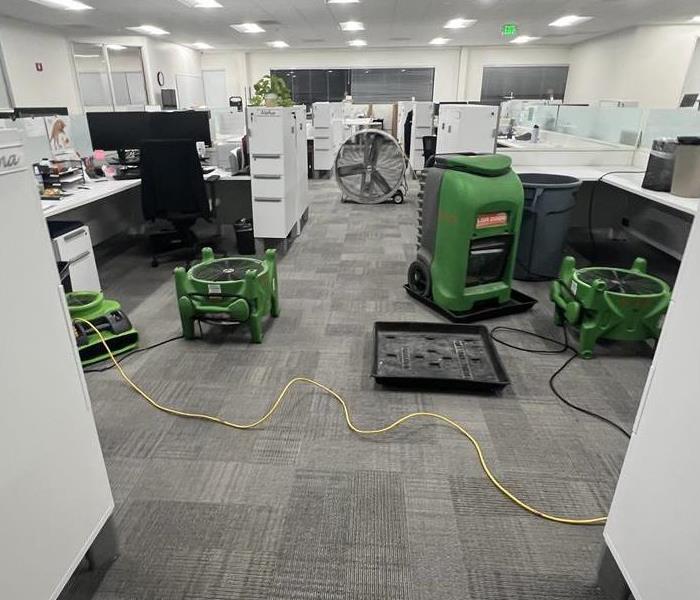 SERVPRO® uses the latest in restoration technology to keep downtime due to loss to a minimum
SERVPRO® uses the latest in restoration technology to keep downtime due to loss to a minimum
SERVPRO® is a professional cleaning and restoration company that can help your office in various ways. Here are some of the ways in which SERVPRO can assist your office:
1. Water Damage Restoration:
SERVPRO can quickly respond to water damage incidents in your office, whether it's due to leaks, floods, or other water-related issues. They can extract water, dry affected areas, and prevent mold growth, helping to minimize damage and restore your office space.
2. Fire Damage Restoration:
In the unfortunate event of a fire, SERVPRO can provide fire damage restoration services. This includes cleaning smoke residues, deodorizing, and repairing structural damage. They work to get your office back to its pre-fire condition.
3. Mold Remediation:
If your office has mold growth, SERVPRO can assess the situation, contain the mold, remove affected materials, and clean and sanitize the area. They also take steps to prevent future mold growth.
4. Storm Damage Cleanup:
After a severe storm or natural disaster, SERVPRO can help with cleanup and restoration. This includes removing debris, drying and cleaning affected areas, and repairing structural damage caused by the storm.
5. Commercial Cleaning Services:
SERVPRO offers regular commercial cleaning services for offices. This includes carpet cleaning, upholstery cleaning, HVAC system cleaning, and general janitorial services. A clean office environment promotes a healthier workplace for your employees.
6. Biohazard and Crime Scene Cleanup:
SERVPRO has trained professionals to handle biohazard situations and crime scene cleanup. They can safely clean and disinfect areas affected by biological or chemical contaminants, ensuring the space is safe for everyone.
7. Document Drying and Restoration:
In the event of water damage affecting important documents, SERVPRO provides document drying and restoration services. They use specialized techniques to salvage and restore water-damaged documents, books, and files.
8. Odor Removal:
SERVPRO can address persistent odors in your office, whether they are from smoke, mold, or other sources. They use specialized equipment and techniques to eliminate odors and improve indoor air quality.
9. Emergency Ready Profile (ERP):
SERVPRO offers an ERP service, where they assess your office space and create a comprehensive profile of important information in case of an emergency. This can help you minimize business interruption during a disaster by having a plan in place.
By utilizing SERVPRO's services, you can ensure a prompt and professional response to various emergencies and maintain a clean, safe, and healthy environment for your office.
Don't Let Disaster Stop Your Business
10/3/2023 (Permalink)
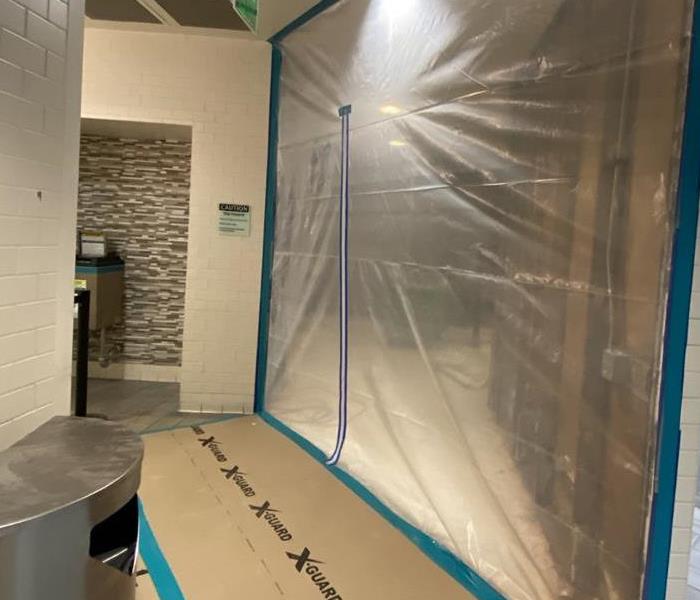 Fast action turned a blown broiler from disaster to better than new
Fast action turned a blown broiler from disaster to better than new
SERVPRO® is the premiere company specializing in fire and water cleanup and restoration services. If your business has experienced damage due to fire, water, or other disasters, SERVPRO can provide several benefits to help you recover and get back on track:
1. Rapid Response: SERVPRO offers 24/7 emergency services, meaning they can respond quickly to mitigate damage and prevent further issues.
2. Professional Expertise: SERVPRO technicians are highly trained and certified in the latest restoration techniques. They know how to assess the damage, develop a plan, and execute it efficiently.
3. Advanced Equipment: SERVPRO uses state-of-the-art equipment for cleaning, drying, and restoring your property. This helps in minimizing the damage and reducing the restoration time.
4. Insurance Liaison: Dealing with insurance companies can be complicated. SERVPRO can help manage the insurance paperwork and process, making your life easier during a stressful time.
5. Preventing Secondary Damage: Water and fire damage can lead to secondary issues like mold growth and structural damage. SERVPRO experts understand how to prevent these secondary damages, saving you money in the long run.
6. Thorough Cleanup: Whether it's water extraction, smoke damage cleanup, or mold remediation, SERVPRO ensures a thorough cleanup, leaving your business safe and habitable.
7. Minimized Downtime: By efficiently restoring your business premises, SERVPRO helps in minimizing downtime. This is crucial for businesses, as it reduces the impact on revenue and operations.
8. Professional Odor Removal: Fire and water damage often bring unpleasant odors. SERVPRO has specialized techniques to remove these odors, ensuring your business space smells fresh and clean after restoration.
9. Customized Solutions: Every business is unique, and so is the restoration process. SERVPRO provides customized solutions tailored to your specific needs, ensuring a personalized approach to the restoration of your business.
10. Peace of Mind: Knowing that professionals are handling the restoration process can provide peace of mind. You can focus on other aspects of your business while SERVPRO takes care of the cleanup and restoration.
The Role of SERVPRO® Plays in Storm Damage Recovery
9/18/2023 (Permalink)
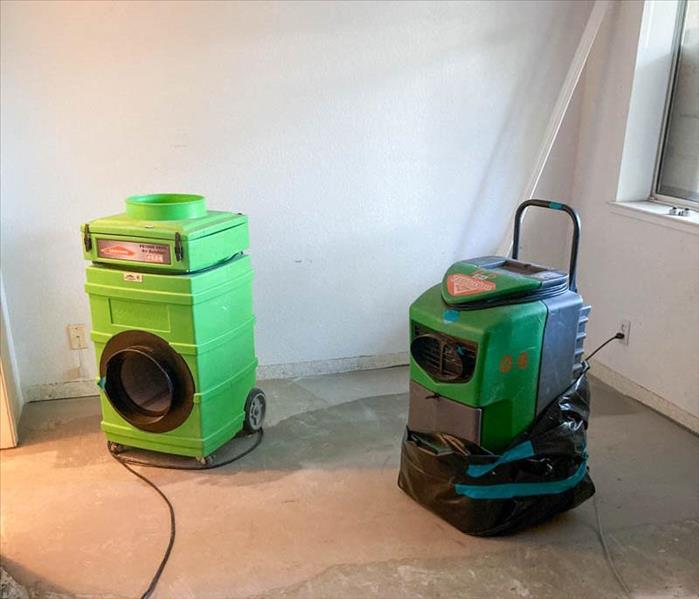 When it comes to storm damage recovery in the Campbell area, our SERVPRO team is your go-to choice.
When it comes to storm damage recovery in the Campbell area, our SERVPRO team is your go-to choice.
When storms wreak havoc on homes and businesses, the road to recovery can seem daunting. That's where SERVPRO® steps in as your trusted ally in storm damage recovery. As the leading restoration company in Campbell, CA, SERVPRO understands the unique challenges that come with storm damage and is well-equipped to help you navigate through the restoration process.
Understanding the Types of Storm Damage
Storms can cause various types of damage, including floods, water intrusion, wind damage, and structural issues. Our SERVPRO's team of experts is trained to identify and address each type of damage effectively. Whether it's extracting water, drying out affected areas, or repairing structural elements, SERVPRO's expertise ensures a comprehensive restoration.
Immediate Response and Assessment
Time is of the essence when dealing with storm damage. SERVPRO recognizes the urgency and prides itself on providing a swift response to your call. Upon arrival, our team conducts a thorough assessment to evaluate the extent of the damage. This assessment serves as the basis for developing a customized restoration plan tailored to your specific needs.
Professional Cleanup and Restoration
With advanced equipment and techniques, our team ensures an efficient cleanup and restoration process. Our skilled technicians employ state-of-the-art water extraction and drying methods to eliminate excess moisture and prevent further damage. In instances where mold growth has occurred due to prolonged exposure to water, our crew can address mold remediation as part of the restoration process. Furthermore, our team is capable of handling structural repairs, making sure your property is restored to its pre-storm condition.
Collaborative Insurance Claims Process
Navigating insurance claims after storm damage can be overwhelming. SERVPRO simplifies this process by working closely with insurance companies. Our team assists with documentation, communicates directly with adjusters, and ensures a seamless claims process, providing you with peace of mind during the restoration journey.
Contact and Service Area
SERVPRO is proud to serve the Campbell, CA, area. If you require storm damage recovery assistance, don't hesitate to reach out to us. You can contact our dedicated team at (408) 371-4001 or check out our website for more information.
When it comes to storm damage recovery in the Campbell area, our SERVPRO team is your go-to choice. With our expertise, prompt response, and commitment to customer satisfaction, we are dedicated to helping you restore your property after a storm. Trust SERVPRO of Campbell as your reliable restoration partner and let us mitigate the damage, so you can focus on rebuilding and moving forward.
How to Create an Office Fire Escape Plan: Your Guide to Safety and Preparedness
8/2/2023 (Permalink)
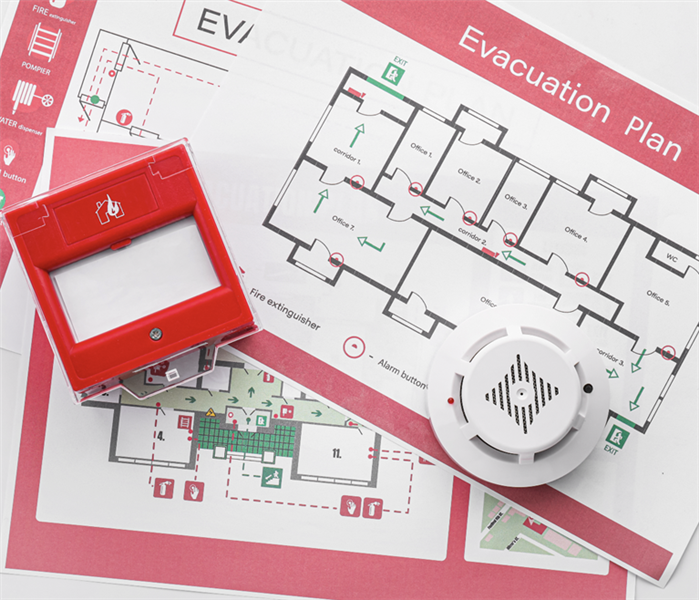 Having a fire escape plan is vital to ensure your business is safe.
Having a fire escape plan is vital to ensure your business is safe.
Ensuring the safety and well-being of everyone in your office is of paramount importance, especially when it comes to emergency situations like fires. Having a well-designed fire escape plan in place can help minimize the risk and potential harm. In this blog, we'll guide you through the steps of creating an effective office fire escape plan.
Assess Your Office Space
Start by thoroughly assessing your office space, taking note of potential fire hazards, emergency exits, and any areas that may pose a challenge during an evacuation. Consider factors such as the size of your office, the number of employees, and the layout of the space.
Designate a responsible individual or a team to take charge during emergencies. This person(s) should be knowledgeable about the fire escape plan, emergency procedures, and should be capable of maintaining calm and leading others to safety.
Identify and Communicate Escape Routes
Identify and mark the primary and secondary escape routes throughout your office. Ensure that these routes are easily accessible, clear of obstacles, and well-lit. Make sure all employees are aware of these escape routes and know where to find them.
Once you have established the fire escape routes, make sure to communicate the plan to all employees. Conduct regular safety meetings and training sessions to ensure that everyone understands their roles and responsibilities during an evacuation. Provide clear instructions on how to navigate the evacuation routes and where to assemble outside the building.
Install Smoke Detectors and Fire Extinguishers
Ensure that your office is equipped with functioning smoke detectors and fire extinguishers. Regularly inspect and maintain these devices to ensure their effectiveness. Educate employees on how to use fire extinguishers safely and effectively.
Regularly conduct fire drills in your office to familiarize everyone with the fire escape plan. These drills will help employees become more comfortable and confident in responding to emergencies. Use these drills as an opportunity to identify any potential issues or areas for improvement in your escape plan.
Periodically review and update your fire escape plan as necessary. Changes in office layout, personnel, or equipment may require adjustments to the plan. Ensure that new employees receive proper training and have a clear understanding of the evacuation procedures.
Having a well-designed and communicated fire escape plan is vital for ensuring the safety of your office and its occupants in the event of a fire. By assessing your office space, establishing clear escape routes, communicating the plan to all employees, and conducting regular drills, you can create a safer work environment and be better prepared to handle emergency situations. Remember, it's always better to be proactive and prepared rather than reactive and caught off guard.
Building with Care: How to Prevent Water Damage During Construction
7/24/2023 (Permalink)
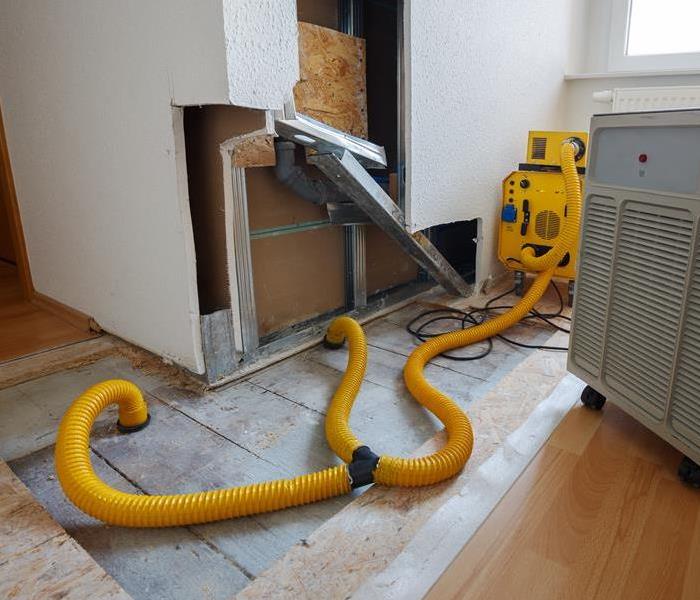 Protecting your business during construction is crucial to prevent water damage.
Protecting your business during construction is crucial to prevent water damage.
Water damage during construction can be a costly and time-consuming problem that can significantly delay a project and incur additional expenses. Taking proactive measures to prevent water damage is crucial for the successful completion of any construction project. In this blog post, we will discuss important strategies and best practices to help you prevent water damage during construction, ensuring a smooth and efficient construction process.
Create a Detailed Construction Plan
Before starting any construction project, develop a comprehensive plan that includes a thorough assessment of the site and potential water-related risks. Consider factors such as the topography, drainage patterns, and existing water sources. By understanding these factors, you can implement preventive measures tailored to the specific needs of the site.
Install Proper Drainage Systems
Effective drainage systems are essential to prevent water accumulation and potential damage. Ensure that the site is properly graded to direct water away from the construction area. Install temporary or permanent drainage systems, such as trenches, swales, or French drains, to redirect water flow and prevent pooling.
During construction, it is crucial to protect building materials from exposure to moisture. Store materials in covered areas or use waterproof coverings to shield them from rain, snow, or other sources of water. Proper storage and protection will help maintain the integrity of materials and prevent water damage.
Implement Temporary Waterproofing Measures
Utilize temporary waterproofing measures to safeguard vulnerable areas of the construction site. Apply waterproof coatings or membranes to exposed surfaces, such as foundations, walls, or roofs. Install temporary barriers, such as tarps or plastic sheeting, to protect areas where water infiltration is likely.
Regularly inspect and maintain the site's drainage systems to ensure they are functioning optimally. Clear any debris or obstructions that may impede water flow. Monitor and address any signs of poor drainage, such as standing water or erosion, promptly.
Protect Openings and Penetrations
Properly seal and protect all openings and penetrations in the building envelope to prevent water intrusion. Install temporary or permanent waterproof barriers around windows, doors, vents, and other openings. Use appropriate sealants and flashing materials to ensure a watertight seal.
Promote safe construction practices that minimize the risk of water damage. This includes covering partially completed structures overnight or during inclement weather to protect them from water exposure. Additionally, establish protocols for immediate cleanup and drying of any water spills or leaks that occur during construction.
Stay informed about weather forecasts and anticipate potential weather events that could lead to water damage. Implement precautionary measures when adverse weather conditions are expected, such as heavy rain or storms. Adjust construction schedules accordingly to avoid working during periods of high risk.
Regularly Inspect and Test Systems
Throughout the construction process, conduct regular inspections and testing of water-related systems, such as plumbing, roofing, and waterproofing installations. Identify and address any issues promptly to prevent potential water damage.
Consult and collaborate with experienced architects, engineers, and contractors who specialize in water management and construction best practices. Their expertise will ensure that proper measures are taken to prevent water damage and address any potential risks effectively.
Preventing water damage during construction requires careful planning, proactive measures, and diligent monitoring. By implementing strategies such as creating a detailed construction plan, installing proper drainage systems, protecting building materials, implementing temporary waterproofing measures, and maintaining proper site drainage, you can significantly reduce the risk of water damage and ensure a successful construction project. Taking these preventive steps will save time, money, and resources, allowing for a smooth construction process and a structurally sound building in the end.
Essential Steps to Prepare Your Commercial Building for Bad Weather in California
6/14/2023 (Permalink)
 Preparing your commercial building for bad weather in California is crucial for minimizing risks and protecting your assets.
Preparing your commercial building for bad weather in California is crucial for minimizing risks and protecting your assets.
As a business owner in California, it's crucial to prepare your commercial building for the potential impact of bad weather events. California's diverse climate presents various weather challenges, including storms, wildfires, and earthquakes. Taking proactive measures to protect your commercial property can minimize damage, ensure employee safety, and maintain business continuity. In this blog, we will provide you with valuable tips on how to prepare your commercial building for bad weather in California.
Understand Potential Weather Risks
Start by understanding the specific weather risks associated with your location in California. Research historical weather data, consult local meteorological resources, and stay informed about weather forecasts. Identify common threats such as heavy rainstorms, high winds, heat waves, wildfires, or seismic activity that may affect your area. This knowledge will help you tailor your preparations accordingly.
Create an Emergency Response Plan
Develop a comprehensive emergency response plan for your commercial building. Assign responsibilities to key staff members, designate evacuation routes, and establish communication protocols. Include procedures for sheltering in place, securing important documents, and shutting down critical systems if necessary. Regularly review and practice your emergency response plan to ensure everyone is prepared and aware of their roles during a weather-related event.
Perform Regular Maintenance and Inspections
Regular maintenance and inspections are essential to identify potential vulnerabilities in your commercial building. Check and repair the roof, gutters, and downspouts to prevent leaks and water damage. Ensure proper drainage around the property to mitigate the risk of flooding. Inspect windows, doors, and exterior walls for gaps or cracks that could compromise the building's integrity during high winds. Regularly service HVAC systems and electrical equipment to minimize the risk of malfunctions.
Secure Outdoor Areas and Equipment
Take measures to secure outdoor areas and equipment that may be vulnerable to bad weather. Trim overhanging branches or remove trees that pose a risk of falling during storms. Secure loose objects, signage, and outdoor furniture to prevent them from becoming projectiles in high winds. If applicable, consider installing storm shutters or protective coverings for windows and doors.
Backup Important Data and Systems
Ensure that your critical data and systems are backed up and protected. Regularly back up your important files, documents, and data to an off-site location or cloud-based storage. Implement surge protectors and uninterruptible power supply systems to safeguard sensitive electronic equipment. Consider investing in a generator to maintain an essential power supply during an outage.
Communicate and Educate Employees
Effective communication is vital during bad weather events. Keep your employees informed about weather updates, emergency procedures, and evacuation plans. Conduct training sessions to educate your staff on how to respond to different weather scenarios and emphasize the importance of their personal safety. Encourage open communication channels so that employees can report any concerns or potential hazards.
Preparing your commercial building for bad weather in California is crucial for minimizing risks, protecting your assets, and ensuring the safety of your employees and customers. By understanding potential weather risks, creating an emergency response plan, performing regular maintenance, securing outdoor areas, backing up data, and communicating effectively with your employees, you can enhance your readiness and resilience in the face of adverse weather events.
At SERVPRO of Campbell, we understand the importance of proactive preparation and offer professional disaster restoration and recovery services for commercial buildings. Our experienced team is equipped to handle the aftermath of weather-related incidents, providing efficient and comprehensive restoration solutions to get your business back on track.
The Mold Remediation Process: A Comprehensive Guide to Removing Mold Safely and Effectively
5/17/2023 (Permalink)
 Mold remediation is a complex process that involves a number of steps.
Mold remediation is a complex process that involves a number of steps.
Mold remediation is the process of removing mold from a building and preventing it from returning. Mold can spread quickly and cause secondary damages so it's important to address it as soon as it's discovered. In this blog, we'll discuss the mold remediation process and the steps involved.
Assessment and inspection
The first step in the mold remediation process is to assess the extent of the mold growth and inspect the affected area. This may involve testing the air quality and moisture levels, as well as visually inspecting the area for mold growth.
Containment
Once the affected area has been identified, the next step is to contain the mold to prevent it from spreading to other areas of the building. This may involve sealing off the area with plastic sheeting and using negative air pressure to prevent mold spores from spreading.
Removal of mold
The next step is to physically remove the mold from the affected area. This may involve removing contaminated materials, such as drywall, carpeting, or insulation, or using specialized cleaning solutions to remove mold from hard surfaces.
Cleaning and disinfecting
After the mold has been removed, the area will need to be thoroughly cleaned and disinfected to prevent mold from returning. This may involve using specialized cleaning solutions and techniques, such as HEPA vacuuming, to remove any remaining mold spores.
Restoration
Depending on the extent of the mold damage, the affected area may need to be repaired or restored. This may involve replacing damaged materials, such as drywall or insulation, or repairing any structural damage.
Prevention
Finally, steps will need to be taken to prevent mold from returning. This may involve addressing any underlying moisture issues, such as leaks or high humidity levels, and taking steps to improve ventilation and airflow in the affected area.
In conclusion, mold remediation is a complex process that involves a number of steps, including assessment and inspection, containment, removal of mold, cleaning and disinfecting, restoration, and prevention. If you suspect that you have mold in your home or building, it's important to address it as soon as possible to protect your health and prevent further damage. By working with a professional mold remediation service, you can ensure that the mold is properly removed and that steps are taken to prevent it from returning.
Reasons to replace your supply lines.
3/8/2023 (Permalink)
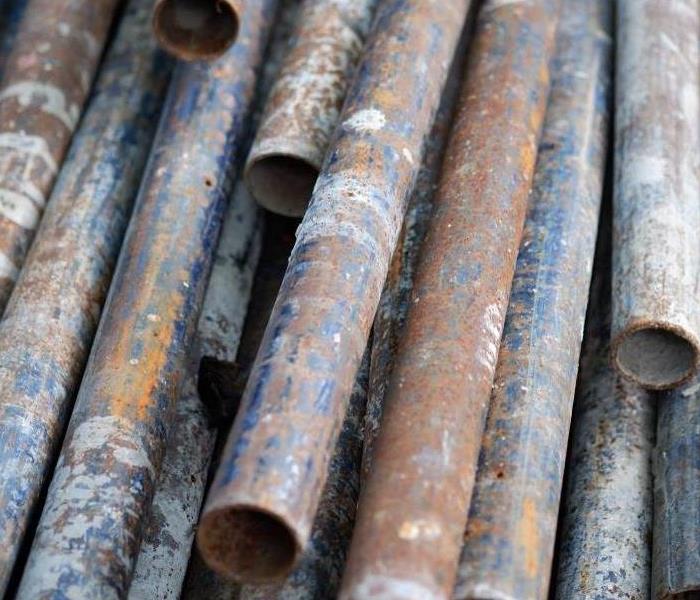 Replace old supply lines to help prevent future water damage.
Replace old supply lines to help prevent future water damage.
Water lines and pipes can be a homeowner's best friend or worst enemy, depending on how well they are maintained. It's important to know that even if your water supply line doesn't look like anything is wrong with it, it could be at risk for breaking and causing costly repairs and water damage. If you find that you have a broken supply line, it's best to replace it right away so that your home doesn't experience any further problems.
Wear and Tear
As you know, the supply lines that bring water into your home are often not visible. This means that they can break without you knowing it, causing costly repairs and water damage. In addition to this, older supply lines are more likely to break than newer ones because of their age and material (plastic).
If you have an older home with plastic piping, it's time for a change. The good news is there are many options available for replacing your old pipes with PVC or copper piping systems that have been designed specifically for homes like yours.
Overlook Damage
A supply line is the pipe that connects your home's plumbing system to the city or town's water main. The supply line is what brings fresh, clean water into your home. If a broken supply line isn't fixed quickly and properly, it can cause extensive damage to your property and lead to costly repairs.
Replace quickly
If you find that you have a broken supply line, it's best to replace it right away. Broken supply lines can be a fire hazard and can also cause water damage. Additionally, they could lead to mold and mildew growth on your walls or ceiling if not addressed immediately. Replacing the entire faucet system is expensive, but replacing just the supply lines will help prevent these issues from occurring in the future!
Even if it doesn't look like anything is wrong with them, your supply lines should be checked at least once a year. Your local SERVPRO professional can help you determine if you need new supply lines or if it's time for other maintenance such as cleaning and flushing your system. If you're unsure if your supply lines need to be replaced, contact your local SERVPRO of Campbell professional. They can help you determine if it's time for new ones or if other maintenance is needed.
5 Types of Damages from a Storm
2/11/2023 (Permalink)
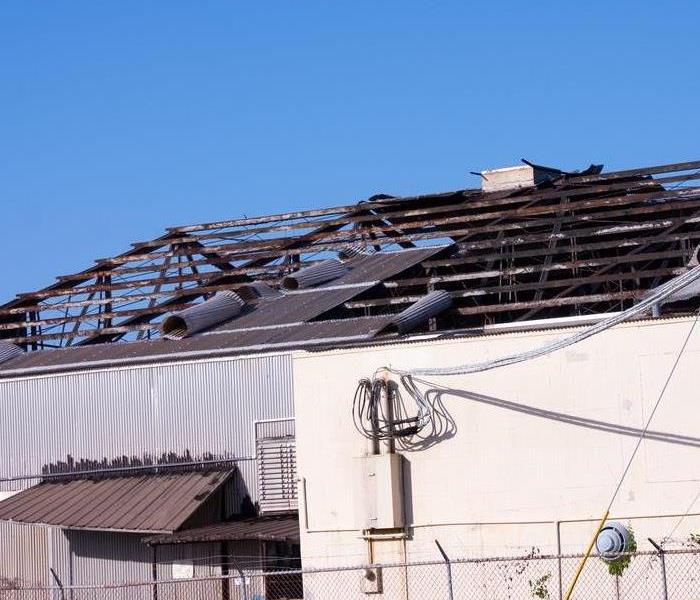 When your property suffers roof damage, give us a call.
When your property suffers roof damage, give us a call.
You've probably seen the news and thought to yourself that it would be pretty bad to have a storm come through your town. But did you know that storms can cause significant damage to buildings and property? There are several types of damages caused by storms, including roof damage, broken windows, water damage and debris littering the premises.
Roof damage
If you’re dealing with a roof that has been damaged by a storm, it can cause structural damage to your house and lead to interior problems problems. It can also lead to electrical problems. The most common types of roof damage include:
- Water damage – water leaks into the ceiling and walls, causing mold and mildew.
- Electrical problems – lightning strikes during stormy weather could cause your electrical system to fail or start fires.
Broken windows
Broken windows are a common occurrence during storms. Broken windows can cause water damage, which can lead to more damages in your home if a professional is not called immediately. Broken windows can also be dangerous for pets, who could get stuck or injured by broken glass shards.
Water damage
Water damage is one of the most damaging types of storm-related damage. It can be caused by broken pipes, burst water heaters, and flooding. Water damage can cause mold and mildew to grow in your home. Wood will rot if you don’t address it quickly after the storm has passed through your area. Electrical systems may fail due to water damage as well as flooring that warps from being saturated with too much moisture from rainfall or floodwaters
Debris littering the premises
Debris is one of the most common damage caused by storms, and it can be dangerous for you and your property. Debris may include tree limbs, roofing materials, doors, tables and furniture. Each piece of debris can cause injury to people or damage to property. Additionally, they create a fire hazard if they are left in place too long after a storm has passed through an area. It is important that these items be removed as soon as possible so they do not present additional risks to those who live in the area or visit it after the storm has occurred.
Commercial and Residential Property
In addition to causing damage to houses and other residential structures, severe storms can also cause damage to commercial buildings. The same forces that cause roof shingles and siding to blow off a home will also rip the roof off of a commercial building, or even completely destroy it. Since most commercial buildings are constructed with concrete walls and steel beams, they don't have much flexibility when they're hit by strong winds—and this means that if you're living above a strip mall or shop in an area that's prone to severe weather, there's a good chance your building could be damaged by high winds.
Inspect Your Building for Signs of Damage
In order to get an idea of what kind of repairs might be necessary after the storm passes through your area or if it hasn't passed through yet, take some time before the storm arrives so that you can inspect any problems areas on your property where water may leak inside during heavy rains or floods such as around windows.
It is important to know what kind of damage your building has sustained and how you can mitigate it. Give the professionals a call to quickly assess the damage of your home or business property to help reduce doors closed or excessive expense to your pocket book.
How Does An Electrical Fire Happen?
12/5/2022 (Permalink)
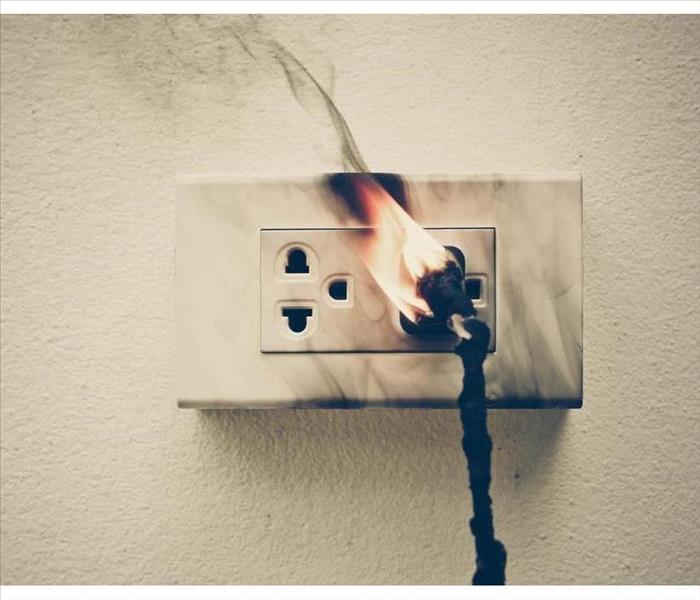 Electrical fires can be caused by short circuits.
Electrical fires can be caused by short circuits.
What Causes an Electrical Fire and How To Prevent Them?
The fact that electrical fires happen more often than most people think makes it even more important to be aware of what causes them and how to stop them. By understanding what an electrical fire is, you'll be able to spot potential problems before they start.
Electrical fires are the third most common cause of house fires in the United States.
Every year, there are over 100,000 electrical fires in homes and buildings that result in more than 400 deaths. In addition to these dire statistics, electrical fires also cause thousands of injuries every year.
The majority of electrical fires start due to wiring issues. This includes shorts or loose connections as well as faulty extension cords and power strips. Other causes include overloaded circuits, damaged cables/connectors, overloaded outlets and frayed wires on appliances or lamps.
What is an electrical fire?
An electrical fire is a fire that starts because of electricity. Electrical fires can be caused by short circuits, overloaded circuits, or overheating. Electrical fires can start in your home or office in Saratoga, CA and spread quickly. The flames from electrical fires are often very hot and may cause damage to the building's structure and contents. If you have an electrical fire, you should leave the building immediately! Then call 911 to report it.
What causes an electrical fire?
Electrical fires can occur when an electrical circuit is damaged or worn out. This can happen when wires are frayed or bent, or if the insulation is damaged on a wire. Electrical fires may also start as a result of poorly installed wiring that has not been put together correctly. In these cases, there may be exposed metal parts where they shouldn’t be, and this can cause a short circuit and fire.
Short circuits are usually caused by an electrical device that has been plugged in incorrectly or plugged into an outlet with too low of voltage for it to work properly. Another common cause of short circuits is water damage to the wiring, which causes corrosion and results in loose connections between wires inside your home's walls.
What should you do if you have an electrical fire?
If you notice an electrical fire, it's important to act immediately:
- Call 911. Electrical fires are extremely dangerous, and they can spread quickly. It's best not to attempt to put out the fire yourself in these cases.
- Stay out of the room—and keep children and pets away as well. Electrical fires release toxic fumes and may cause injury if you try to fight them yourself or if they ignite nearby objects such as carpeting or furniture that could burn through walls into other parts of your home.
- Have a fire extinguisher handy.
A final reason why an appliance might catch fire is because its internal parts have become exposed due to damage caused by normal wear-and-tear over time; this type of malfunction should always be addressed quickly so as not interfere with daily life too much since it could cause major problems down the road."
Conclusion
Electrical fires can be scary and dangerous, but they’re also preventable. If you know what to look for and how to prevent them, you can keep your home safe from electrical fire damage. The best way to avoid electrical fires is by being aware of what causes them in the first place: using extension cords or power strips that aren’t meant for high-powered appliances; overloading outlets with too many things plugged in at once; placing items on top of electrical outlets where they could potentially encounter moisture or other moisture-producing elements like basements and bathrooms.
Making a Water Damage Claim
11/7/2022 (Permalink)
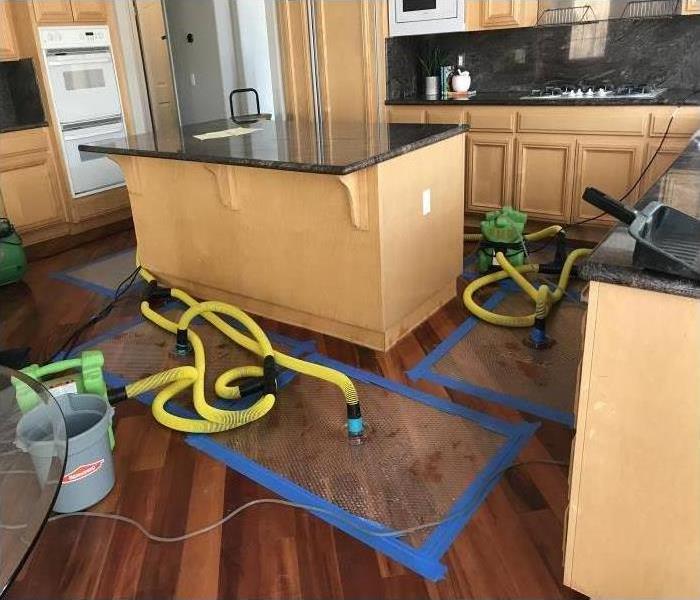 Water damage in a home in San Jose, CA
Water damage in a home in San Jose, CA
Dealing with Water Damage
The moment you realize that water is making its way into your home is a scary one. It doesn't matter if the flooding came from rain or burst pipes—the damage can be devastating and costly. Whether the water was caused by an accident or just bad luck, you'll need to act fast to get things under control. We've put together this guide to help you handle the situation and make sure your insurance company covers all of your losses.
Shut the Water Off
First, you'll want to shut off the water at the main. If you're not sure how, call a plumber—or look online for instructions on how to shut off your water supply.
The second thing is that you need to get it fixed as soon as possible. If possible, find a business in your area that specializes in repairing pipes and getting them back up and running again so that they don't burst again in the future (or worse).
While you wait for the repairman, call SERVPRO of Campbell and your insurance company, and follow these steps until help arrives:
Remove as much water as you can.
Use a wet-dry vacuum on any carpeted areas, and remove excess water with a mop. Never use a broom or brush, as they can damage the surface of your flooring. Never use towels to soak up water—they can leave lint behind that will attract dirt and bacteria in the future. Never leave fans running in your home after a flood event, because they may cause moisture damage to your ceiling or walls.
Remove the Items from Harm’s Way
When dealing with water damage, it's important to remember that your property can be replaced. Your home is not the only thing that needs to be protected; any valuable items in the area should be removed immediately and placed out of harm's way. This includes clothes, furniture, electronics, and anything else you may have in the vicinity.
If there is any damage done to your possessions - even if you aren't sure if there is or not - make sure to document as much as possible before removing them from the affected area. Take pictures of all areas where damage has occurred so that you have a visual record for insurance purposes later on when filing a claim. If there are any services required from companies like plumbers or electricians in order to fix those problems after taking out the damaged goods from their compromised areas (e.g., fixing water leaks), keep receipts for these purchases as well so that they can be added into your insurance claim if necessary
Living Arrangements
If your home in San Jose, CA is considered unlivable due to water damage, ask if your insurance will cover the cost to stay at a hotel while repairs are being made. This can be for up to 10 days if you live in an area that has been declared a disaster area by FEMA.
It's important because you don't want to return home only to see more damage happening because of lack of electricity from flooding or mold growth from not having proper ventilation and drying out time.
Don’t Wait to Call the Experts
Don't try to repair the damage yourself, and you don’t have to wait until the insurance company sends someone. You can call SERVPRO of Campbell the moment disaster strikes, and we will be out quickly to help clean up the mess and put your property back together.
The most important thing to remember is that every water damage claim is different. The process can take time and may require multiple phone calls or emails to your insurance company. If you have any questions, contact us today
What Should I Do If My Roof is Damaged in a Fire?
10/5/2022 (Permalink)
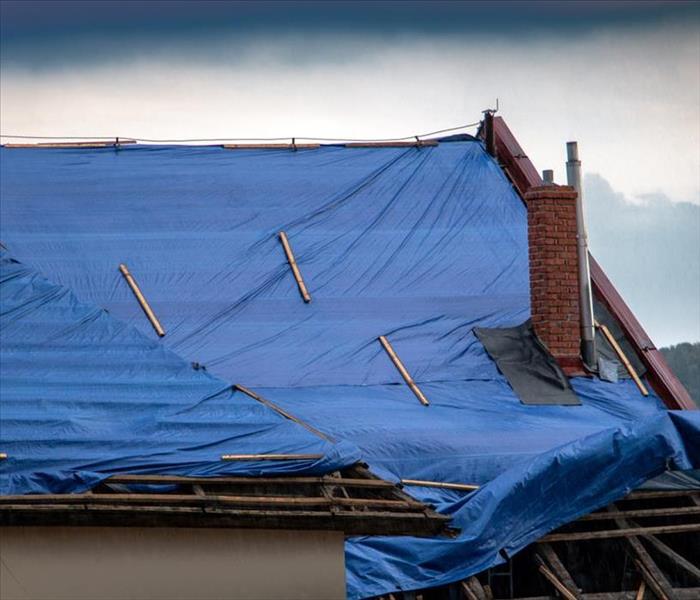 Tarping your roof after a fire will protect it from water damage
Tarping your roof after a fire will protect it from water damage
What Must I Do If a Fire Causes Damage to My Roof?
After a fire, it's common for your roof to sustain some kind of damage. While you may not need to replace the entire roof, there are certain steps that can be taken to ensure that your home in Los Gatos, CA is safe from further damage and that it will remain standing for years to come.
Tarp Your Roof After a Fire
Tarping the roof after a fire is one of the most important things you can do to protect your home. The tarp will keep water and other elements out of your house and prevent it from leaking, which could damage the structure of your home.
The tarping process should be done correctly by professionals who know how to properly protect your property from water damage during this delicate time.
Why Tarps are Necessary After a Fire
You should be aware that tarps are necessary for a number of reasons. First, and most obviously, tarping your roof after a fire will protect it from water damage. This is important because once the rain starts up again (and it will), any exposed wood on your home's exterior will begin to swell and warp in the wetness, eventually causing significant structural damage to your house's framework. Tarping also keeps out animals and debris like leaves or twigs that can cause additional problems with erosion over time; as well as keeping out heat or cold depending on when you choose to cover up your home's exterior after a fire has occurred.
It is Important to Have a Professional Tarp Your Roof
A professional will understand the best process for tarping your roof as well as the importance of doing it correctly:
- Roof tarps will keep the elements out and prevent further damage to your roof.
- Roof tarps are necessary to keep the roof watertight, which is important for preventing further damage to the interior of your house.
Tarping your roof after a fire can be an expensive and time-consuming process. However, it is an important one that should not be taken lightly. The last thing you want to happen is for water damage or mold to start growing because the tarps were not installed correctly or were left off for too long. If you are dealing with this situation, please contact us right away so we can help!
3 Tips For Reducing Candle Fires in Your Home
8/29/2022 (Permalink)
 It is best to either avoid using candles while kids or pets are present
It is best to either avoid using candles while kids or pets are present
Three Ideas to Cut Down on Candle Fires in Your Home
Many people use candles in their Saratoga, CA, homes. They can help you achieve a certain atmosphere or add a pleasant aroma to a room. There are, however, some risks when you are using fire in your house. Following proper safety measures can reduce the chances of a candle fire.
1. Extinguish Unattended Flames to Avoid Candle Fire
If you are leaving the room for an extended period of time or you are going to bed, always extinguish your candles first. Even if it seems unlikely that something will catch fire, accidents are always possible. For example, a draft could cause the flame to grow or the candle could burn too low and shatter the container. To prevent this, never leave a lit candle unattended.
2. Keep Candles Out of Reach of Children and Animals
Children and pets often have a lot of energy and may not be aware of the dangers present in their surroundings. If they accidentally knock over a candle, it could quickly turn into a much larger candle fire. It is best to either avoid using candles while kids or pets are present or to keep a very close eye on them.
3. Remove Flammable Items From the Area
Your home is most likely full of items that could easily catch fire if they came into contact with a candle. Flammable liquids, bedding, curtains, paper and similar items should be kept out of the immediate area where the candle is in use. If you are using multiple candles, they should be spaced at least a few inches apart.
You don’t have to stop using candles, but you should be aware of how you use them. Fire and smoke cleanup and restoration can be a lengthy process. Using candles more safely can help you prevent fires and keep your home and family safe.
3 Kinds of Hidden Damage to Watch For After a Partial-Loss Fire
8/20/2022 (Permalink)
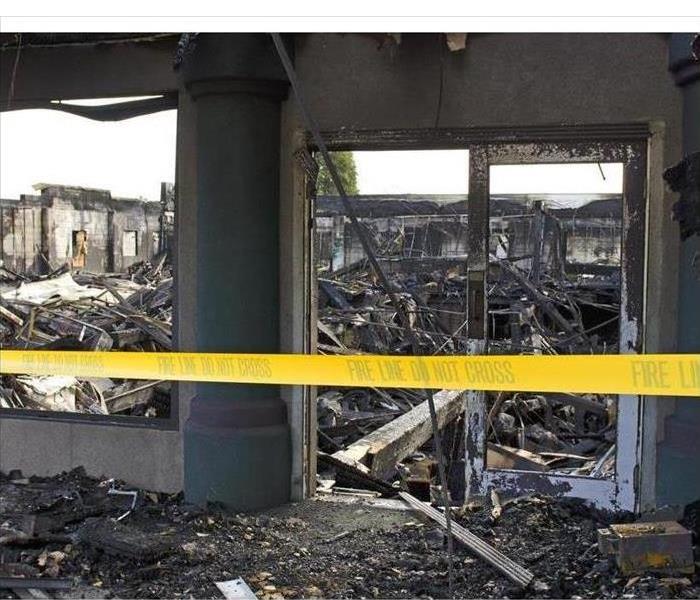 Commercial fire damage in Campbell, CA.
Commercial fire damage in Campbell, CA.
After a Fire with Partial Loss, There Are 3 Types of Hidden Damage to Look Out For
Any type of fire loss can cause a major disruption to your Campbell, CA, business. However, things can get particularly complicated in the event of a partial loss. In the insurance world, the term partial loss refers to a situation where a fire occurs but does not destroy the entire building. A partial loss fire often causes unseen damage, which results in insufficient insurance claims and, consequently, inadequate fire restoration work. Be wary of these three commonly overlooked sources of hidden property damage after a partial loss fire.
1. Smoke Damage
Where there's fire, there's smoke and in a business fire, smoke, soot, and ash usually spread much farther than the flames themselves. In most cases, nearly every interior surface will need to be cleaned and deodorized to eliminate soot stains and smoke odors. This type of cleanup should only be done by a professional remediation company, using specialized cleaning agents and techniques. Some items may be too damaged to restore and will need to be replaced. Porous surfaces, such as carpet and upholstery, are at a higher risk of total loss from soot and smoke damage.
2. Water Damage
A common side effect of fire loss is water damage, usually caused by the high pressure and large volume of water used to put out the fire. Mold growth often begins within the first 24 hours after a fire and can spread through the building's air ducts to areas beyond the fire-damaged zone. Unchecked mold growth can cause serious property damage to your building. A certified industrial hygienist should conduct a full mold inspection after any fire.
3. Heat Damage
The intense heat produced by a fire can cause significant damage to your building. At extreme temperatures, the glass may warp, and window or door frames may blister or melt. Iron or steel can transfer heat to other areas, causing structural instability. An engineer's inspection is often the best way to detect this damage.
A fire loss doesn't have to destroy your entire building to cause widespread property damage. Checking for these damage sources will ensure that your insurance claim and restoration measures are adequate.
Signs That You Need A Hot Water Heater Repair
8/15/2022 (Permalink)
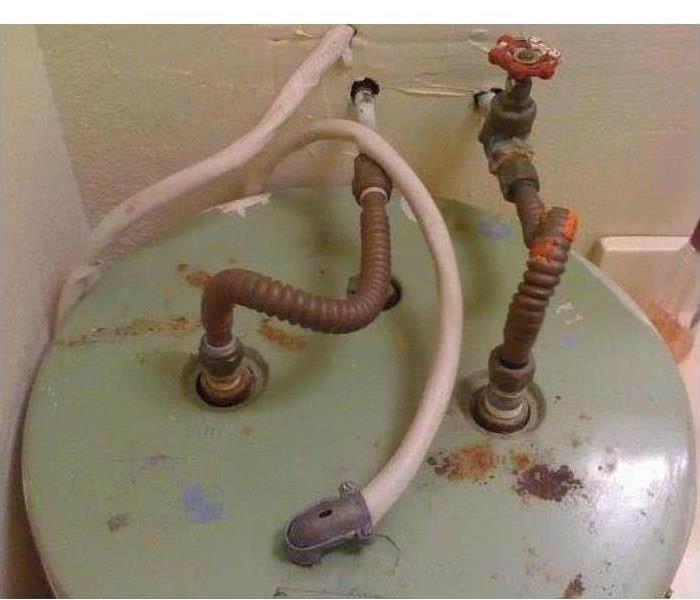 It’s important to have your water heater repaired as soon as you see these signs.
It’s important to have your water heater repaired as soon as you see these signs.
What Are The Signs Of Hot Water Heater Going Bad?
Water heaters are essential elements of our home. We use them in daily activities such as taking a bath, using the dishwasher and using the washing machine. But because we use them frequently, it’s sometimes easy to take them for granted and forget that they need to be maintained. Failing to do so will result in malfunctions and problems and eventually, replacing your water heater. Taking notice of the first signs of a problem can help you repair your water heater before it becomes worse.
You don’t have to be an expert to spot the first signs of trouble. All you need to have is a keen sense of observation so that your water heater can be repaired.
1. Hot water has an off smell or off-color. The first instance that you notice your hot water has an off smell or has a rusty color, that’s something that you need to check out. The smell could be the result of a rusty anode rod in the water heater. There is no need to worry since the anode rod can be replaced which will then eliminate the bad odor. Bacteria growth also causes bad smells. This happens when the hot water has not been used or has been turned off for quite some time or when the thermostat is set at a very low level.
2. Corroded pipes can also cause an off-color in your water. This can be solved by installing a water softener or by replacing the plumbing. If you also see a lot of sediments in the water, it’s time to have the water heater repaired.
3. Water is not hot enough, too hot, not strong enough or there is none at all. When there is no water, check first that your water heater has power and is working fine. If it is, have it inspected by a plumber. If water is not enough, this could be due to an undersized water heater and is a common situation when a lot more people are using the water heater. This could also be caused by the presence of mineral deposits inside the water heater tank. When water is too hot or not hot enough, you may have to adjust the temperature dial of the water heater. If there is no change in temperature, have the water heater checked and repaired.
4. Strange noises and leaks. Leaks coming from your water heater could lead to flooding. In the same way, strange noises like pops, bangs, gurgles, and the like are clear indicators that something is wrong with your water heater. This is usually caused by a buildup of sediments inside the tank. A boiling sound, however, could mean the water heater is overheating or that pressure is building up inside the tank. All these have to be addressed immediately to prevent further problems.
It’s important to have your water heater repaired as soon as you see these signs. This will help you save on costs, prevent further damage, and avoid an untimely replacement of your unit.
What To Do After Flooding If You Don’t Have Flood Insurance
7/29/2022 (Permalink)
 FEMA can provide four types of assistance.
FEMA can provide four types of assistance.
What to Do If You Don't Have Flood Insurance After a Flood
Homeowners insurance policies typically exclude damage caused by flooding. Residents of flood-prone areas should obtain a separate flood insurance policy, otherwise they will have to pay for damage restoration out of pocket or obtain relief through a federal program. Here are four types of assistance that may be available through the Federal Emergency Management Agency.
1. Transitional Sheltering and Temporary Housing
After the president declares a federal disaster area, Transitional Sheltering Assistance can lower the cost of staying in a hotel during the days or weeks immediately following a disaster. Homeowners can also seek Temporary Housing Assistance for a period of one month up to 18 months.
2. Grants for Cleanup and Restoration
A homeowner may want to apply for a grant to fund the restoration of a residence located on a flood plane. Grants can be used for repairing structural damage or replacing other losses.
3. Repair and Replacement Assistance
If the location of your home is declared a federal disaster area, you may be eligible for a one-time payment for Repair and Replacement Assistance. This option will not cover the costs of flood damage, and is intended to supplement a flood insurance policy.
4. Low-Interest Loans
It may be possible to obtain loans that have low interest rates to finance residential flood damage repairs. These loans are usually capped at $200,000 for a primary residence and $40,000 for property including renters' losses. Annual interest rates may be as low as 1.75 percent for a 30-year period.
After a federal declaration of emergency, homeowners may benefit from these and other services administered by FEMA. If you obtain flood insurance, you should seek an estimate from storm and water damage restoration experts and make a claim. Professional cleanup and rebuilding services can reduce the likelihood that secondary damage will result from primary flood damage at a residence in San Jose, CA.
4 Steps for Writing a Business Continuity Plan
7/24/2022 (Permalink)
 Business Continuity Plan
Business Continuity Plan
Planning for your business in Santana Row, CA, is always a good idea, especially in an emergency. Find out below how to make an emergency plan and why you need one.
How Do I Create a Business Continuity Plan?
It is like working on a giant puzzle: you already know some important details; the process will help you fill in the rest.
1. Make a Business Impact Analysis
A BIA shows how various scenarios will impact the essential functions of your business. Think about supply chain disruptions and other external consequences as much as internal ones like loss of revenue.
2. Decide on Recovery Options
You should know what it will take to recover and what is currently available. Strategize your recovery methods and select the best to implement.
3. Team Up
Create a team to help develop your plan. You will also have to create an emergency personnel structure showing roles and responsibilities. Also, think about running operations manually if your IT department is offline.
4. Test and Exercise Your Plans
You need to test your plans to know if they will work. Testing might mean running your fire alarms or tornado sirens. Full-scale exercises like tornado drills ensure everyone knows where to go and can include timing them to see how long it takes.
What Is a Business Continuity Plan?
It is a plan for what you and everyone that works for you need to do to keep the business running as normally as possible in case of an emergency.
Why Do I Need a Business Continuity Plan?
Without continuity plans, as many as 75% of companies fail within three years. Having a plan means your company is more likely to recover when a disaster strikes.
Having an emergency response plan is crucial for your business when disasters happen.
How To Minimize Water Damage After a Pipe Burst
7/13/2022 (Permalink)
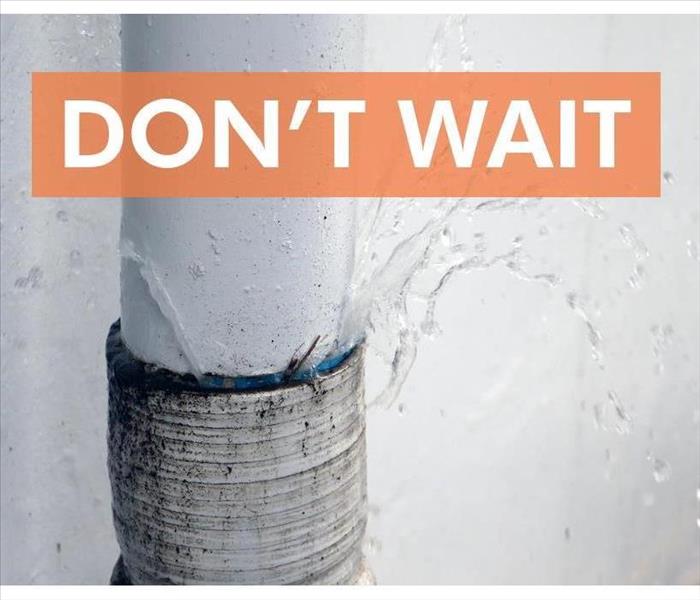 A leaking pipe will become a burst pipe causing flooding and three to five days of cleanup.
A leaking pipe will become a burst pipe causing flooding and three to five days of cleanup.
Water Damage Tips
A burst pipe is a common way that water damage can negatively affect your business. Being aware of water damage tips can help you save important items. This guide can assist you in minimizing the damage and starting the cleaning process.
Signs of a Pipe Burst
Knowing the signs of a damaged pipe is crucial to neutralize the threat of water damage before it can begin. Keep your eyes and ears peeled for:
- Knocking pipes
- Cracked or displaced tiles
- Musty or humid smells
Water Damage Tips
If you can't avoid a burst pipe, there are ways to minimize water damage to a commercial building. Start by cutting power to the affected areas of the building. Contact a building manager or the utility company if the shutoff is near an affected area.
Next, you'll want to stop the water at its source, as doing so minimizes the impact of the emergency. Contact building management if the shutoff isn’t readily available. When the water has been shut off, there will be excess flow in the pipes. Open up faucets and place buckets and containers underneath them.
Finally, collect items that are not tolerant to water exposure. Place them in water-proof containers, move them to unaffected areas, or remove them from the building altogether.
Expert Help
The cleaning tips are designed to help minimize damage, but you’ll need to call in professionals to help with the aftermath, starting with your insurance company. You'll want to ensure they keep a record of the damage.
Depending on the severity of the damage, you may require a plumber's expertise for pipe repairs. A plumber can give you tips in case anything happens in the future.
If there has been extensive water damage, you may also need assistance from a West Valley, CA, water restoration company. These businesses assess the damage and restore the building to its pre-damaged state.
Water damage can be devastating to a business. Utilizing these damage tips and services will help to create a smooth recovery process.
3 Functions of an Electronic Claims Service
6/14/2022 (Permalink)
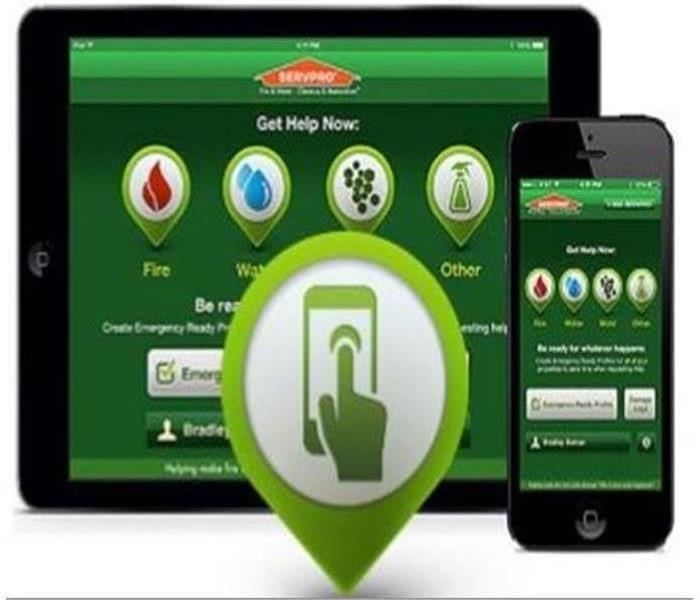 Choosing a provider with an electronic claims service allows for more transparency.
Choosing a provider with an electronic claims service allows for more transparency.
Three Functions of an Electronic Claims Service
In the event that disaster strikes a residential or commercial property in Monte Sereno, CA, the owner may need to make an insurance claim. Insurers prefer to work with restoration companies that maintain rigorous professional standards and digitize records. Here are three notable differences between a restoration company that still deals in paper documents and a nationwide service network with an electronic claims service.
1. Provide Authorized Access
An electronic claims service can restrict access to claim-related documents to authorized parties. Rather than processing paperwork that is only secure until it is not, and which can be damaged or misplaced, an electronic service requires authentication for access and backs up files.
2. Track an Insurance Claim
The SERVPRO electronic claims service can also improve the ability of a property owner or insurance agent to keep track of the materials involved in a property damage claim. While property owners should still retain copies of damage documentation, proof of loss and a restoration estimate, an electronic claims service provides peace of mind that critical documents cannot be accidentally destroyed or misplaced.
3. Support Instant Communication
The availability of up-to-date materials in an electronic claims service is essential for speedy claim settlement. A service that notifies users when new materials become available has clear advantages over disjointed analog workflows. While an electronic claims service may not yet support internal live communication, these materials are readily available to be referenced in calls between insurance providers, policyholders and a restoration service provider.
In the event that you need to make an insurance claim for a property located in Monte Sereno, CA, choosing a provider with an electronic claims service allows for more transparency. These services provide authorized parties with persistent access to claim materials, deliver updates and ensure that all stakeholders are working from the same up-to-date documentation.
What To Do If Your Bathtub or Toilet Overflows
6/2/2022 (Permalink)
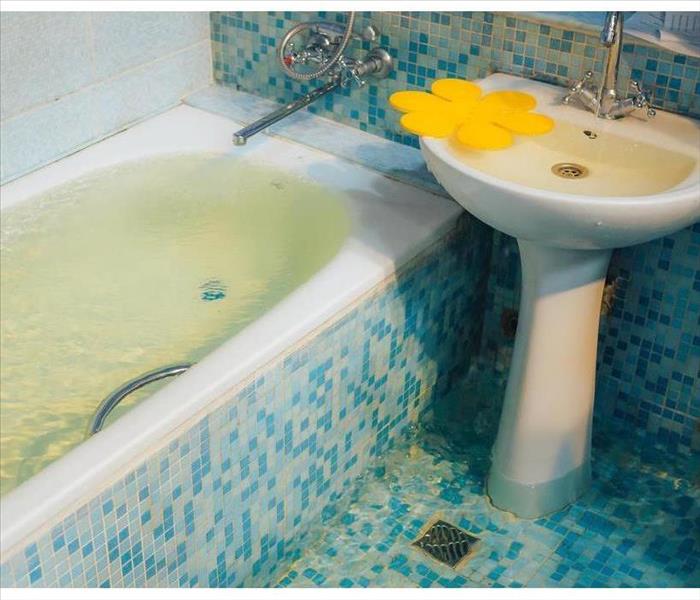 Overflowing water in your bathroom can be the result of a sewer backup.
Overflowing water in your bathroom can be the result of a sewer backup.
Sewer Backup In Your Bathroom
Plumbing issues can happen to any homeowner. There are several reasons that this can occur, including broken pipes, a clog or blockage, and severe weather in Los Gatos, CA. If you are experiencing a sewer backup in your bathroom, there are a few steps you should take.
1. Turn Off the Water
One of the first things you should do during a toilet or bathtub backup is turn off the water source to your house. This will help limit the amount of water that enters the building. Continuing to use the plumbing can contribute to the overflow.
2. Move Belongings to a Dry Space
Dry items that have not been touched by the overflowing water should be moved to another location to keep them safe. Do not move anything that has been contaminated into a clean area. If there is an excessive amount of water in the room, do not enter it without protective clothing. Water from a sewer backup is highly-contaminated and unsafe.
3. Contain the Flooding Area
Depending on how badly the plumbing fixtures are overflowing, the contaminated water could start to flow into other areas. To keep the water from moving into the rest of the house, block off the bathroom the best you can.
4. Contact a Professional
If you are struggling to take care of the issue on your own, don’t hesitate to contact a professional. A water damage remediation company will be much better equipped to handle sewage water than you are. They can clean it up safely, make necessary repairs and locate the source of the problem as well.
Overflowing water in your bathroom can be the result of a sewer backup, causing contaminated water to enter your home. There are steps that you can take to keep your belongings and home from additional damage, but these should only be done if it is safe for you to do so. Because this water is unsafe to handle without protective gear, contacting a professional is often a better approach than attempting to clean it on your own.
3 Reasons To Consider Hiring a Professional Contractor To Handle Your Mold Problem
5/24/2022 (Permalink)
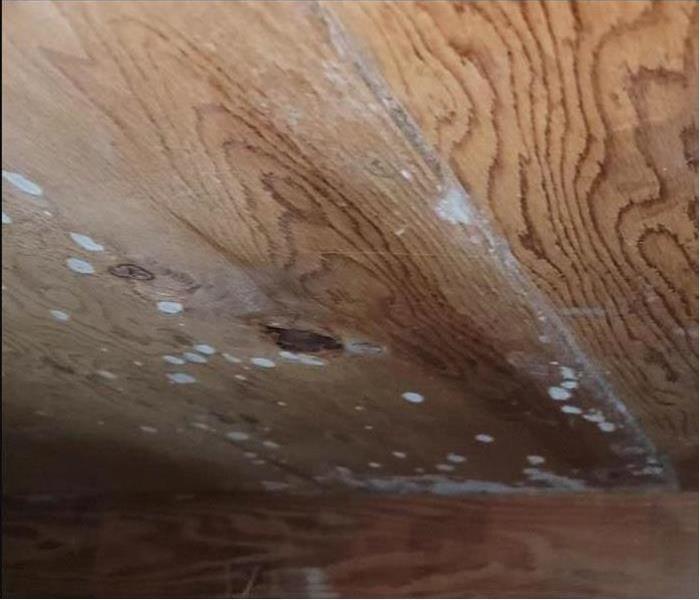 We are mold-certified mold remediation specialists in Saratoga, CA.
We are mold-certified mold remediation specialists in Saratoga, CA.
Three Reasons to Consider Hiring a Professional Mold Removal Contractor
Pervasive and found in every building regardless of whether or not its presence is visibly detectable, mold is capable of compromising the structural integrity of edifices if given enough time. It is known to devour nutrients in certain construction materials, with wood and paper being especially vulnerable due to their cellulose contents. While it is unable to obtain nutrition from inorganic substances like concrete, because it may thrive in essentially any area where it is damp, dark and cool, there exists the possibility of finding it clinging to almost anything in an establishment. This includes carpets, ceiling tiles, insulation, sheetrock and more. Porous materials are particularly susceptible to being overtaken by invasive microorganisms. If you have discovered mold in your business, contacting a professional remediation company in Saratoga, CA, to handle the fungus cleanup might be the best action to take next. Here's why.
1. Professionals Are Better Equipped To Handle Specific Circumstances
There are situations where the aid of an expert is needed to thoroughly clean up mold. Examples include:
- The mold growth covers an area of significant size
- There is extensive water damage
- Your HVAC system has been overtaken by the fungus
- Water/water damage present is the result of contaminated sources or sewage
2. Bleach Is Less Effective Than Generally Believed
Bleach is the go-to solution when it comes to sanitization/sterilization. It is known for its effectiveness in eliminating certain undesirable microbial life forms. However, the Environmental Protection Agency, or EPA, actually does not suggest using it for fungus cleanup (though there do exist exceptions). This is because of the root system; some mold spores will be left behind after treatment.
3. Simple Wiping Is Often Less Than Sufficient
One of your first instincts might be to spray the mold with a strong disinfectant and wipe it off. However, even if you can no longer see it, wiping it away generally will not remove it completely, for the same reason bleach doesn't.
Fungus cleanup may be a long, difficult process or a quick, easy one. However, if you are unsure about the severity of your infestation, it is often wise to consult a professional.
4 Things To Know About Home Fire Alarms
5/19/2022 (Permalink)
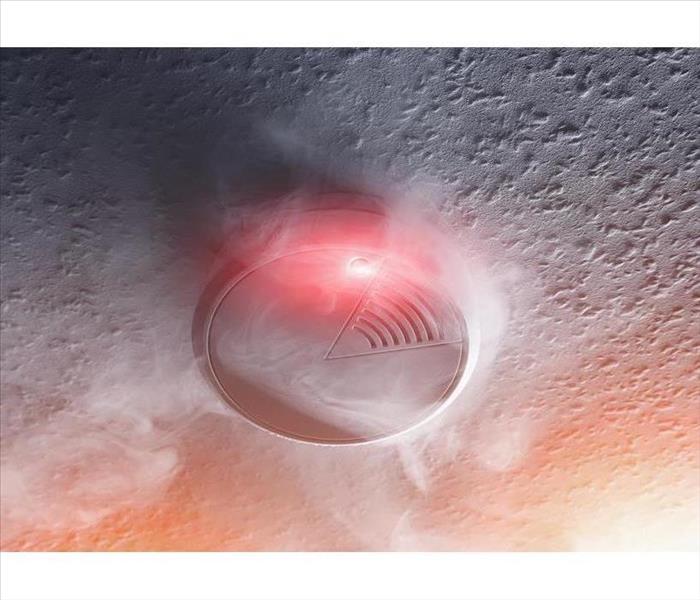 New smoke alarms are simpler to operate than in the past and require less maintenance.
New smoke alarms are simpler to operate than in the past and require less maintenance.
Home Fire Alarms
No home should be without at least one fire alarm to alert all occupants of a potential fire. In recent years, these essential tools have undergone advances in technology that make them more reliable than ever. In fact, the National Fire Protection Association states that homes without working fire alarms are twice as likely to suffer deaths in a fire than homes with working alarm systems. While the choice of installing an alarm in your home in Campbell, CA, is a simple one, it helps to know a little about your choices.
1. A Large Selection. You will find an assortment of fire alarms in stores, most of which will use the latest technology. All are designed to sound off in the case of an incipient fire, to save lives and to prevent fire damage. It is important to look at cost, area of coverage and ease of installation
2. Area of Coverage. A fire alarm system should be the right size for your home. Experts recommend coverage for each bedroom and each floor in the home. If you do not have an integrated alarm system, this means multiple alarms throughout the home. Most homes should have at least five fire alarms.
3. Ease of Operation. New smoke alarms are simpler to operate than in the past and require less maintenance. Most last in the range of 10 years, and there is no need to change batteries, making them effective in preventing smoke damage.
4. Ease of Installation. You should be able to install the units yourself in a matter of minutes. If you do opt for a more complicated system, it is best to hire a professional electrician.
A fire alarm provides essential protection for your home. In the case of property damage caused by fire, be sure to call a local fire restoration franchise to clean your home of the many effects of a home fire.
Protect Your Revenue Stream With Interruption Coverage
5/11/2022 (Permalink)
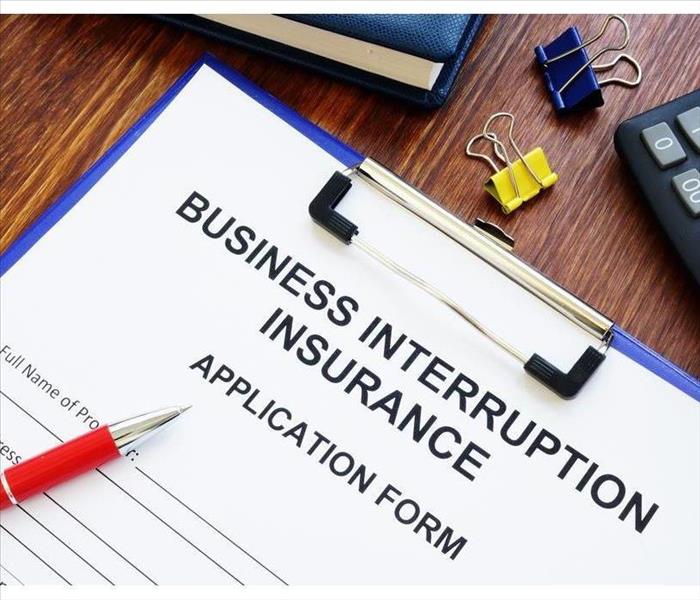 Interruption insurance can extend a lifeline to your company after a fire.
Interruption insurance can extend a lifeline to your company after a fire.
Protect Your Revenue Stream With Interruption Coverage
Whether you own a large company or a smaller one, your revenue stream is vital to your success. Anything that prevents your business from making or selling products and services can lead to a cascading series of problems:
- Inability to pay creditors
- Laying off of staff
- Inability to pay taxes and regulatory fees
Interruption insurance can extend a lifeline to your company after a fire. This is often a time when operations must cease for an indefinite period. Until your facility in San Jose, CA, is restored by a professional fire mitigation franchise, you will likely see a sudden drop in business income.
What Is Covered by Insurance for a Business Interruption
Depending on your policy, it will likely last for the time your facility is shut down after a covered event such as a fire. Its purpose is to restore lost revenue at a critical time, and it can make the difference between a company surviving a fire and one that goes out of business. Typically interruption insurance policies provide payments for a variety of expenses:
- Money for commitments such as loans or taxes
- Payments for company payroll
- Money for lost revenue based on past earnings
- Payments for utilities
- Expenses for setting up a temporary operation center
How Rapid Fire Restoration Helps
Both your company and your insurance provider benefit from an efficient restoration of your commercial building. This reduces expenses across the board, allowing your company to get back to its core business. Successful recovery begins with a team of fire mitigation experts coming on-site and taking care of soot, smoke and water damage. The more efficiently this is accomplished, the quicker your employees can return to work in a safe environment.
Most companies will benefit from an appropriate interruption insurance policy. It will give you peace of mind and take care of expenses after a catastrophe.
5 FAQs About Flood Insurance
4/26/2022 (Permalink)
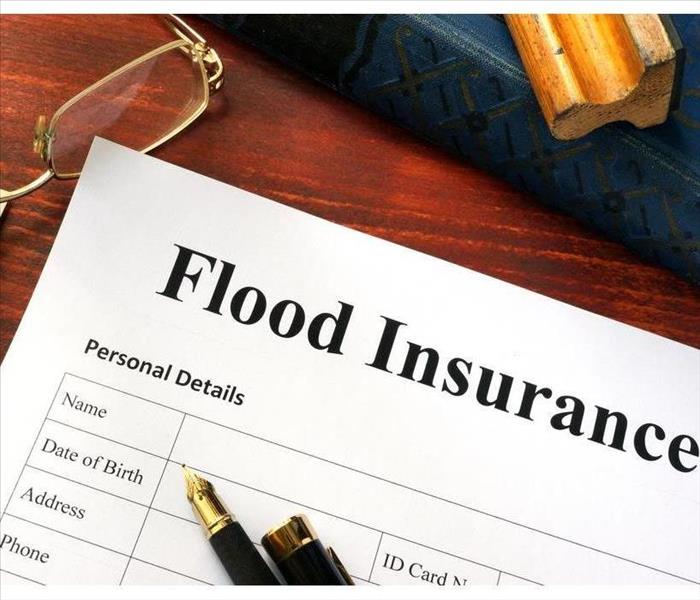 Flood insurance is a policy you can get to offer protection for your business against flood damage.
Flood insurance is a policy you can get to offer protection for your business against flood damage.
Five Flood Insurance Frequently Asked Questions
Some areas practically require a flood policy. In other areas, business owners may not have even heard of flood insurance. If you're in this category, you probably have a lot of questions. Here is some information that can help answer your questions.
1. What Is It?
Flood insurance is a policy you can get to offer protection for your business against flood damage. It is either an add-on or a separate policy from your standard commercial insurance policy, which won't cover flood damage.
2. What Does It Cost?
On average, flood insurance for small businesses in Santana Row, CA, is roughly $1,000 per year. However, what you end up paying for your policy is based on your deductible, how much coverage you want, and your risk levels.
3. Is It Necessary?
You may never actually need your flood insurance. In these cases, you may feel like you are wasting your money on commercial insurance when you could be investing it in new equipment or other items. However, if you don't have flood insurance and you experience flood damage, your business could go underwater trying to pay to repair the damage.
4. How Do You Buy It?
To purchase a policy, you're going to need to talk to your commercial insurance agent. You can also search for alternative providers who offer flood insurance. Before reaching out to an agent, ensure your business meets the requirements for the recommended policy. Pick a company that offers a policy in your price range that covers all of your equipment.
5. Are Elevation Certificates Important?
In high-risk zones, elevation certificates are used to calculate the potential costs of hiring a storm remediation company. These are important because they tell your insurer your elevation, compared to typical floodwater heights.
Ultimately, whether you purchase flood insurance should be based on your comfort level with your current FEMA risk zone. However, you could end up in a situation where you need it to prevent your business from failing.
What Is a Flood Cut and Why Is It Necessary?
4/16/2022 (Permalink)
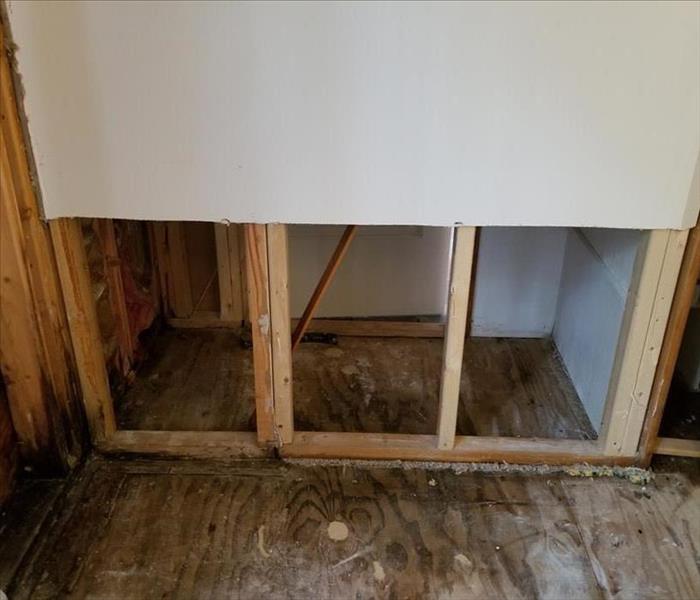 In some instances, a flood cut will need to be made to properly restore the function of your building.
In some instances, a flood cut will need to be made to properly restore the function of your building.
If you have experienced flooding in your commercial building, it may be necessary for the restoration company to perform a flood cut. This is probably an unfamiliar term for most business owners, so this guide will provide a brief explanation of what it is and why it is done.
What a Flood Cut Is
When a water restoration company in West Valley, CA, needs to cut the drywall in your building, this is called a flood cut. The reason this is called a flood cut is that the cut is made 12-18 inches above where the flood damage stops. It is done to facilitate drywall tear-out. A flood cut may be performed in a variety of situations:
- Wall has been touched by sewage water
- Damage is too severe to save the wall
- It isn't practical to dry out the wall without removing sections
When a Flood Cut Is Necessary
Flooding sometimes causes sewer lines to back up which can lead to your building being exposed to contamination. A wall that has been contaminated by sewage can not be salvaged because the materials may contain harmful bacteria or pathogens. Additionally, a flood cut needs to be performed on walls that contain insulation, because insulation can not be dried out and still function properly as insulation.
Situations That Do Not Require a Flood Cut
If the water that damaged the wall was from a clean source, such as a pipe leak, and there is no insulation, the restoration company may be able to salvage the wall by using an injection system to dry out the inside of the wall without cutting the drywall. Most restoration companies will make every effort to salvage as much property as possible.
When a building has been damaged by flooding, restoration services will work with you to attempt to salvage your property. However, in some instances, a flood cut will need to be made to properly restore the function of your building.
4 Tips for Maintaining a Commercial Roof
4/11/2022 (Permalink)
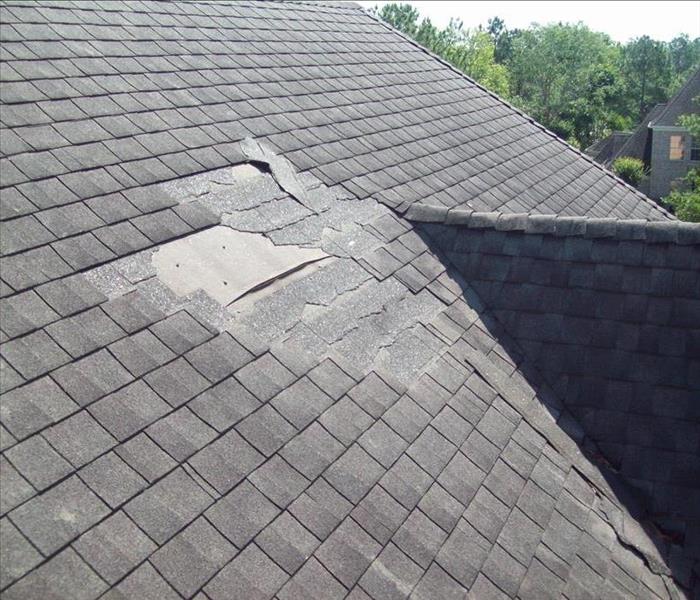 Missing shingles on a roof.
Missing shingles on a roof.
Four Commercial Roof Maintenance Tips
A roof is something that can easily be overlooked, but your Monte Sereno, CA, property relies on it to keep everything underneath it safe and dry. Once roof damage happens, it may mean more than needing a roof rebuild. Missing shingles, damaged membranes and other issues lead to issues that may require the services of water damage and restoration professional. Although the unexpected can happen, the following four tips make it easier for your roof to weather the storms.
1. Preventive Maintenance
The top way to avoid roof damage is to stay on top of maintenance. Business owners should regularly check for any leaks, standing water and blocked drains. These often lead to other issues. Any signs of missing pieces indicate there may be hidden trouble lurking.
2. Regular Inspections
Along with visibly checking the roof, it should be professionally inspected annually. A professional will have the expertise to look for other issues, such as weak spots, sagging and structural issues. Scheduling this inspection may mean the difference between an inexpensive repair and a costly new roof.
3. Keep It Clean
Especially after a storm, it is important to check for wind damage and ensure the roof is clean of leaves and branches. Along with potentially clogging a drain, debris piling up invites the growth of algae. If that happens, it can start to deteriorate the roof faster. It may also lead to mold growth.
4. Inspect Roof Equipment
Most commercial properties have some time of equipment on the roof. Whether an HVAC unit, ventilation, or skylights, these items should be regularly checked to ensure they are functioning properly. If any damage is discovered, repairs should be immediately made to avoid a leak.
Although Mother Nature may eventually lead to some kind of roof damage, staying on top of maintenance and inspections increases the chances of the roof lasting longer.
Roof Leaks and Mold: Your Top Questions Answered
3/31/2022 (Permalink)
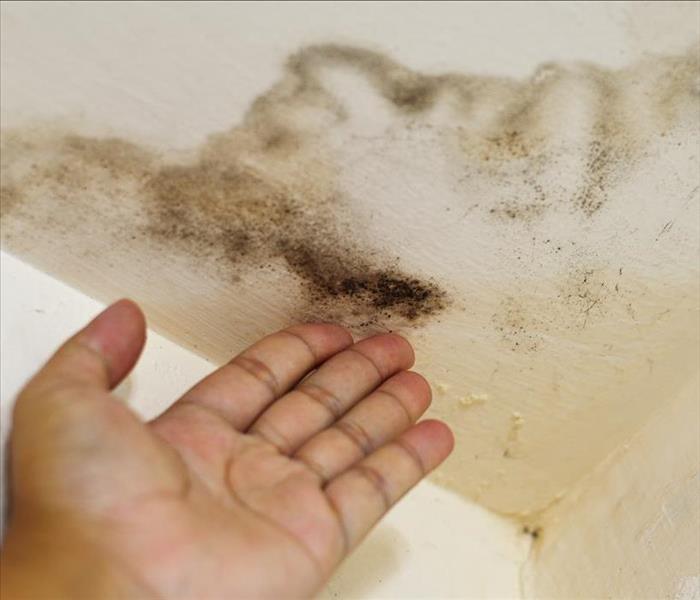 A leaking roof can lead to mold damage.
A leaking roof can lead to mold damage.
Roof Leaks and Mold
The last thing you want to worry about is a leak in your building’s roof. If the leak is small, it can be tempting to stick a bucket under the leak and put off the repairs. Don’t give in to this temptation! A leaky roof can lead to all kinds of problems in a short time, such as black mold, swollen wood, and soggy sheetrock. The answers to the following common questions hold the clues to avoiding a moldy, leaky mess in your Los Gatos, CA, building.
1. How Long Does It Take for Mold To Start Growing?
Mold spores are always present in the air, both outside and in your building. These spores remain dormant while they are airborne. When the spores land on a moisture source, such as a ceiling leak, they begin to feed and reproduce. Since the spores are already present in the air, you don’t have much time after even a small leak before the spores become active. Black mold spores typically become actively growing mold within about 24 hours after the leak begins.
2. How Can I Prevent Mold From Forming?
The key to avoiding a mold infestation is to act quickly as soon as you discover a roof leak. Try to identify resolve the source of the leak, to stop any more water from entering. Use towels or a shop vacuum to dry surfaces as thoroughly as you can. A dehumidifier may also help. If the leak is large, or if you can’t easily identify the source, contact a professional contractor as soon as possible.
3. What If Mold Has Already Appeared?
If the leak has existed for some time before you noticed it, don’t waste time: Contact an experienced mold remediation company right away. DIY cleanup efforts are often ineffective, and mold will continue to multiply in the meantime.
Don’t let a leaky roof turn into a black mold nightmare for your building. Understanding the mold growth cycle and acting quickly when you discover the leak will save you time and money.
Three Steps to Take Immediately After a Building Fire
3/30/2022 (Permalink)
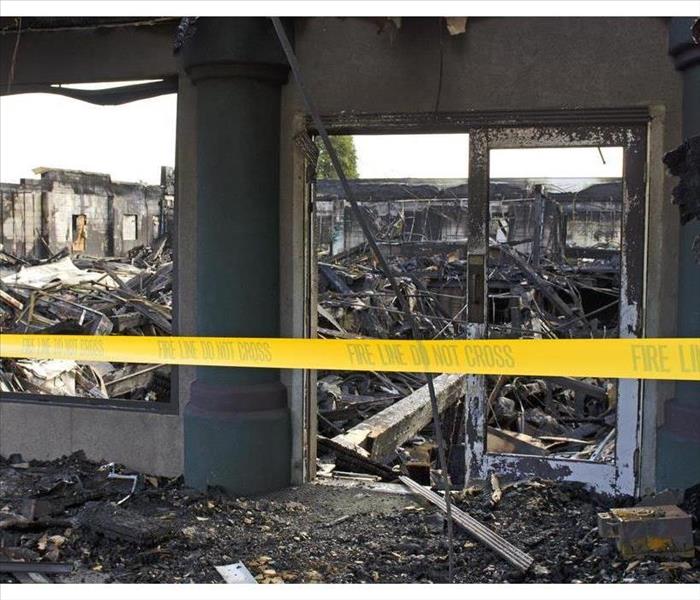 Commercial fire damage in Saratoga, CA.
Commercial fire damage in Saratoga, CA.
What To Do After Sustaining Fire Damage In Your Commercial Building
A destructive fire can be disastrous for a company. If a fire occurs in a commercial building in Saratoga, CA, there are important steps to take immediately after the blaze is extinguished. Here are three suggestions for what to do after sustaining fire damage at a commercial building.
1. Secure the Building
After a fire is doused, other problems may, unfortunately, occur, including looting. Once it is safe to do so, it may be beneficial to secure the building to help deter any thieves from gaining access inside the property and stealing valuable items. Boarding up windows and doors may help to keep intruders out of the business. And if it is safe to enter the building after a fire, consider removing as many valuable items as possible that are salvageable. At a business, these items may include computers, hard drives, various electronic equipment, as well as important files and paperwork.
2. Repair the Damage Swiftly
Fire cleanup and property repair is a top priority. It is important to work with professionals who specialize in fire restoration and repair in order to fix the damage caused by the blaze. Fire damage may cause major structural damage to a commercial building, and ensuring that it is safe – especially for employees to return to work at the business – is vital.
3. Plan for a Road to Recovery for the Business
A fire at a business may result in a loss of revenue for an extended period. Coming up with a plan to handle the possible financial hardship that may follow a disaster is critical. This plan may include relocating employees to a temporary office building or allowing them to work from home so that the company can still operate.
Fire damage can be devastating, but it does not have to destroy a company. Following these tips and addressing the situation in a timely manner may help a business to resume operations quickly.
3 Ways Restoration Professionals Assist Insurance Adjusters
3/25/2022 (Permalink)
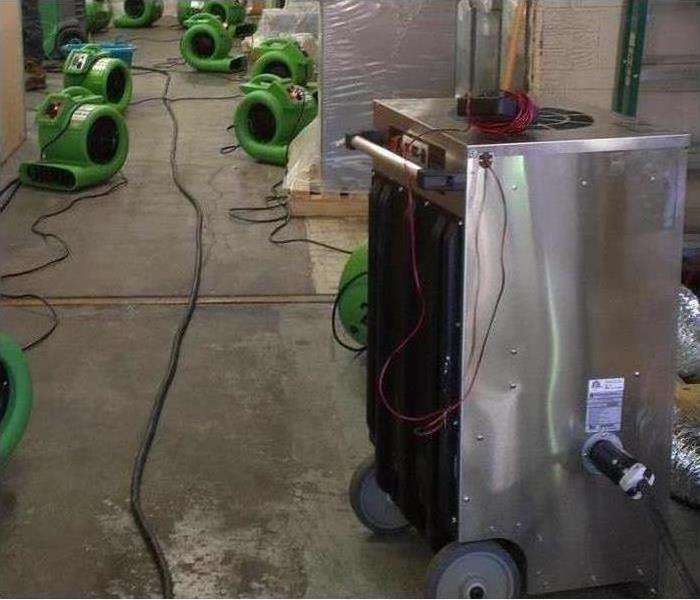 Storm restoration services in Campbell, CA.
Storm restoration services in Campbell, CA.
Restoration Experts Assist Insurance Adjusters in Three Ways
Successful storm restoration depends on collaboration between restoration professionals and insurance representatives. The ready availability of damage documentation and accurate estimates can accelerate the claim settlement process. Whether you are an insurance agent or own property in Campbell, CA, you should be aware of three areas in which insurers and restoration experts can work together to provide the most efficient and effective disaster response services.
1. Restoration Teams Arrive Sooner
Restoration franchises often have the resources necessary to arrive on-site for storm response in less time than insurance representatives. Insurance agents and adjusters may be slowed down by the number of clients reporting damage in an area. Franchises that are part of a large corporate network can readily obtain the staff and resources that are necessary to meet spikes in demand.
2. Restoration Experts Document Damage
Documentation is another area in which restoration professionals can assist insurance representatives with storm restoration. These experts know exactly what to look for in a residential or commercial property that has sustained damage from a storm and can take photos, record videos and make lists of partial and total losses to make insurance adjusters’ and agents’ jobs easier.
3. Mitigation Starts As Soon As Possible
Once the damage has been documented, a restoration team can start taking measures to mitigate flood damage. Pumping out water sooner rather than later may limit the severity of primary damage and prevent secondary damage, such as mold. The first 24 to 48 hours after damage occurs are crucial for successful restoration.
In the event of a major storm that causes large-scale losses, insurance representatives will be tasked with inspecting damage at many properties in Campbell, CA. The ability to rely on a preferred storm restoration vendor to document damage and calculate an accurate estimate of restoration expenses can expedite mitigation in the short term and eventually claim settlement.
Restoring Documents After Water Damage
2/26/2022 (Permalink)
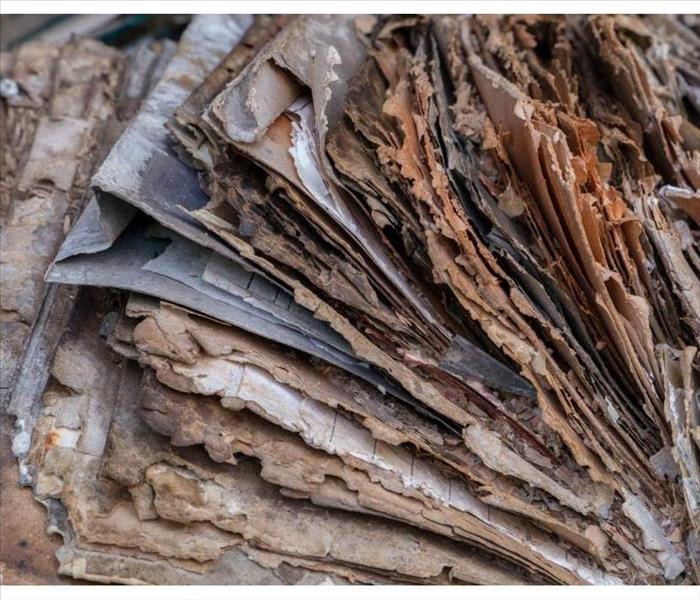 Your clients may be able to salvage documentation that was damaged.
Your clients may be able to salvage documentation that was damaged.
Document Restoration After Water Damage
When a client's property suffers storm damage, it may be on more than just building. A document restoration service like that offered by a local SERVPRO in San Jose, CA, can help your client get back on track. Documentation can include everything from account statements to invoicing, and the ability to salvage these can help save valuable time and money.
Services Offered
A professional restoration service can offer a number of ways to recover your client's documentation. These may include
- Freeze-drying
- Cleaning
- Gamma irradiation sterilization
- Digitizing
- Deodorizing
Depending on damage type, these processes can be utilized to restore a variety of damage documents, including X-rays and photographs.
Technology Used
The process of document restoration involves the use of modern technology. Gamma irradiation is used to sterilize the documents without causing further harm. The documentation can then be freeze-dried which is a process approved by the National Archives. Your client can trust that their paperwork will not only be in safe hands but can be restored. Taking advantage of additional services, such as digitization, may offer further benefit.
Additional Services
In addition to document drying, SERVPRO offers several other services your clients may be interested in. They can also offer digitization services. This is the process of converting documentation into an electronic form so it can be stored on a server safely out of harm's way.
With a document restoration service, your clients may be able to salvage documentation that was damaged along with their other property. A restoration team can use the latest technology to help get these important pieces of paperwork in order. They may also be able to digitize the documentation allowing for it to be backed up on to server, to help prevent any further loss. If you have any questions about what the service can do for your clients, a restoration professional may be able to help.
A Comprehensive Guide on How to Use a Fire Extinguisher
2/21/2022 (Permalink)
 When grabbing an extinguisher, think “PASS.”
When grabbing an extinguisher, think “PASS.”
How to Use an Extinguisher
If you’ve gone your whole life thus far without knowing how to use a fire extinguisher, there’s no need to be too embarrassed! In fact, a majority of Americans claim they don’t know how to use one. Although an extinguisher is rather simple to use, you don’t want to waste time while a fire is quickly spreading in your home in Santana Row, CA. Here are the basics of how an extinguisher works, so you can act swiftly!
When grabbing an extinguisher, think “PASS.”
- Pull the pinout of the handle
- Aim the tip of the nozzle at the bottom of the fire
- Squeeze the extinguisher’s trigger
- Sweep the hose from one side to the other side until the fire is out
Once all these steps are completed, assess the fire damage and called fire restoration services if necessary.
When You Should Use a Fire Extinguisher
You will need to quickly assess the situation and make the decision to either attempt to put out the fire or run. Extinguishers can be used for small fires that just started. For example, a kitchen fire that starts while you’re cooking can easily be put out before it spreads any further. However, a large fire requires you to evacuate the area and contact the fire department.
How To Know Your Extinguisher Is Fit for the Job
There are several different extinguishers designed for different types of fires. You will need to check the label of the fire extinguisher to see if it is a Class A, B, or C. This identifies whether it is designed to handle wood and paper product fires, liquid fires, or electrical fires. Some extinguishers are identified as A-B-C and can handle all three types of fires. Also, make sure it is pressurized and charged.
If a fire ever occurs, acting as fast as possible is key to minimizing fire damage to your home. Memorize the information in this guide for the best chance of putting a fire out before it’s too big for you to handle.
Tips for Protecting Your Property from Flood Damage
2/2/2022 (Permalink)
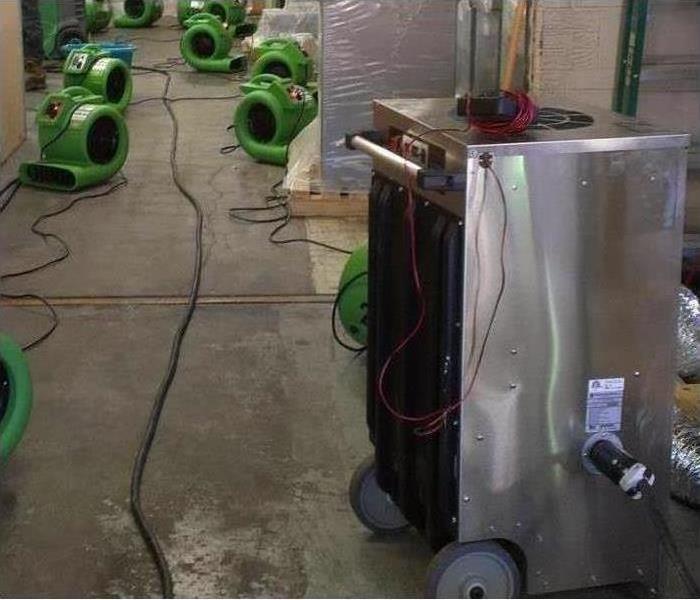 Storm damage in a West Valley, CA warehouse.
Storm damage in a West Valley, CA warehouse.
How To Protect Your Property From Storm Damage and Flooding
Flood damage can seem like a remote, theoretical risk – that is, until it’s in your face. Fact is, experts have estimated flood costs for the globe’s 136 largest coastal cities could cost $1 trillion annually by 2050. Wise property in West Valley, CA, property owners are thinking ahead by creating a flood plan. Not sure how to protect your property from storm damage and flooding? Here are a few tips.
About Floods
Federal officials define flooding as partial or complete inundation of 2 or more acres of normally dry land area or of 2 or more properties. Typical causes include:
- Overflow of inland bodies of water
- Rapid accumulation of surface runoff
- Mudflow
All can create damage, but even just an inch of water can result in recovery costs estimated to average $27,000. Being prepared won’t eliminate the risk, but it can help minimize the costs of recovery.
Inspect Your Property
Part of flood-proofing a building is making sure that you inspect it regularly. Look for cracks in the foundation or other structure systems that could be vulnerable in high waters. Also check:
- Flood panels, to ensure the panels or gaskets are working
- Drainage systems for signs of damage that could prevent the pipes from draining properly
Apply Waterproof Sealants
Invest in waterproof coatings and sealants and apply thoroughly to foundations, walls and even doorways of your property. This so-called “dry flood-proofing” measure can form a thin but sturdy barrier that can minimize flood damage effects.
Invest in Water Pumps
Foundation vents encourage water to flow through a building rather than pooling around it, reducing the pressure flood waters can put on walls. This type of “wet flood-proofing” is particularly useful in buildings with basements.
Flood damage can be devastating both physically and financially. Get ahead of the risk with these tips and by identifying a local water cleanup specialist in case the worst does happen.
Where There’s Fire Damage, There’s Sure to Be Water Damage
1/30/2022 (Permalink)
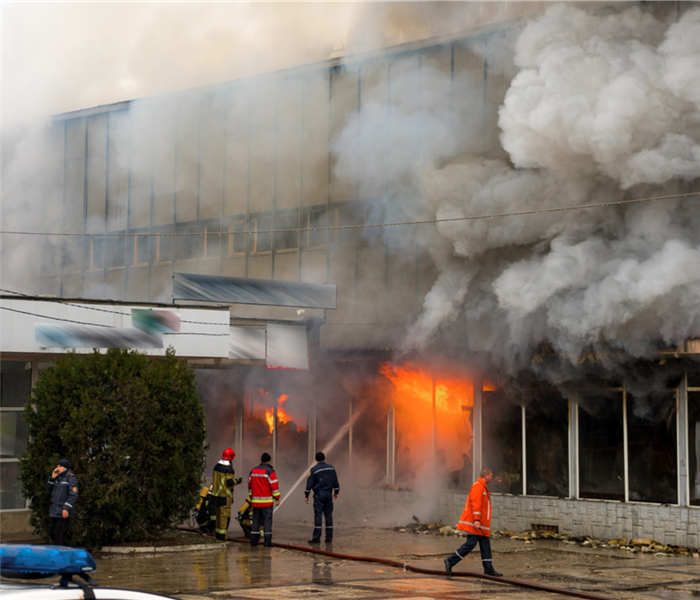 Commercial fire damage in Monte Sereno, CA.
Commercial fire damage in Monte Sereno, CA.
Fire and Water Damage In Your Building
A structural fire can cause serious damage, but unfortunately, the flames aren’t the only damaging element to wreak havoc on your building and its contents. In order to put out a raging inferno, firefighters have to use massive amounts of water and other chemicals, which means that whatever the fire didn’t ruin, the water surely did. In addition to having to deal with fire and smoke cleanup, you will also be forced to deal with water cleanup. So, where do you start? FEMA recommends doing the following immediately after a fire:
- Contact your insurance agency
- Turn off the utilities
- Create as much ventilation as possible
- Contact a cleanup crew
Reach Out to Your Insurance Provider
First things first: you need to report the fire to whichever agency will be compensating you for damages. The longer you wait to report the fire, the slimmer your chances will become of recovering the full cost of damages.
Turn Off the Utilities
This is important for a number of reasons. For one, you can save money by shutting off the utilities you won’t be using for the foreseeable future. Two, by leaving the gas or electrical running, you may unwittingly cause another fire or explosion. If you don’t know which utilities to turn off, the Monte Sereno, CA, water cleanup crew can help.
Create Airflow in Your Building
Part of fire cleanup efforts includes ridding buildings of smoke odors and the harmful contaminants caused by soot. You can aid the fire restoration team in their efforts by opening as many windows as possible and creating adequate airflow. However, only do this once you’ve been given the go ahead by the fire department.
Contact a Water Cleanup Crew
A professional fire cleanup crew can help you separate all salvageable items from the non-salvageable. They will have all the necessary water extraction equipment to effectively free your building of excess moisture and get it to the point where it can be recovered (if that’s an option). Finally, professional cleaners will remove all damaged materials, wash down all surfaces and advise you on what you need to do bring your building back to pre-fire condition.
How to Handle Sewer Backup
1/30/2022 (Permalink)
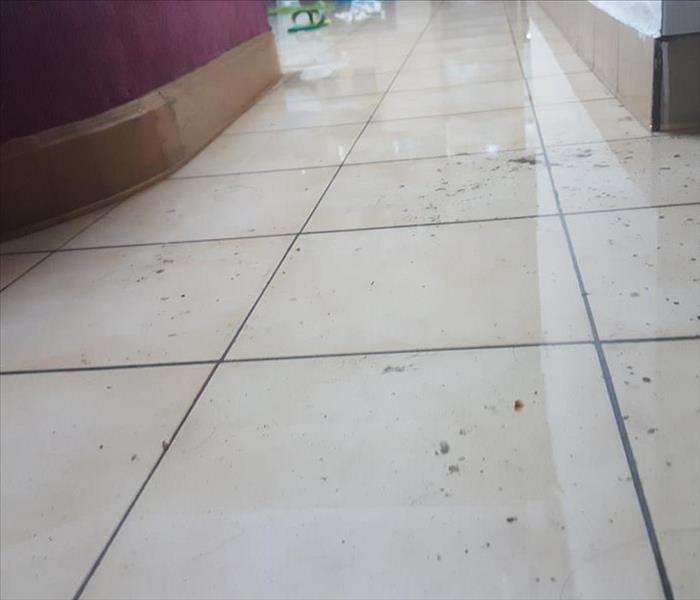 No one wants to have to go through a sewer cleanup.
No one wants to have to go through a sewer cleanup.
How to Deal with a Sewer Back-Up
Of all the dirty jobs you have to do as a homeowner, sewer cleanup is going to take the cake. When there’s a flooded toilet involved, or when a storm triggered a sewer backup, it’s time to start weighing your options. If you’re feeling overwhelmed, here is what happens during a cleanup effort:
Pump It Out and Dry It Out
All the gunk that comes along with a sewer cleanup has to be taken out. You or your cleanup professional will have to start the process right away. Often, sump or trash pumps will be used to clear the water from your home. Then, with the use of fans and dehumidifiers, your residence will be dried.
Restoration and Carpet Repair
Carpets have to be considered in the sewer cleanup. Most of the time, carpets are not able to be saved, they have to be replaced after coming in contact with sewer backup. However, there are cases where they may be able to be salvaged. In these instances, the carpets have to be removed and scrubbed thoroughly. Remember that moisture is a breeding ground for mold, and when it comes to porous belongings, there are places for the mold to hide. Everything must be disinfected and cleaned.
Odor Elimination
The problem after sewer cleanup is that sometimes you still have to figure out what to do about the smell. The cleanup process will remove most of the scent, but not always all of it. If you find that the odor is lingering in your home, you can utilize HEPA air filters to clean the air and air fresheners to make the situation tolerable. Over time, the smell should fade.
No one wants to have to go through a sewer cleanup. It can be a difficult task, but when taken seriously and with the help of specialists in Saratoga, CA, your home can be clean again in no time.
Top Reasons Homeowners Insurance Won’t Pay for Your Mold
1/30/2022 (Permalink)
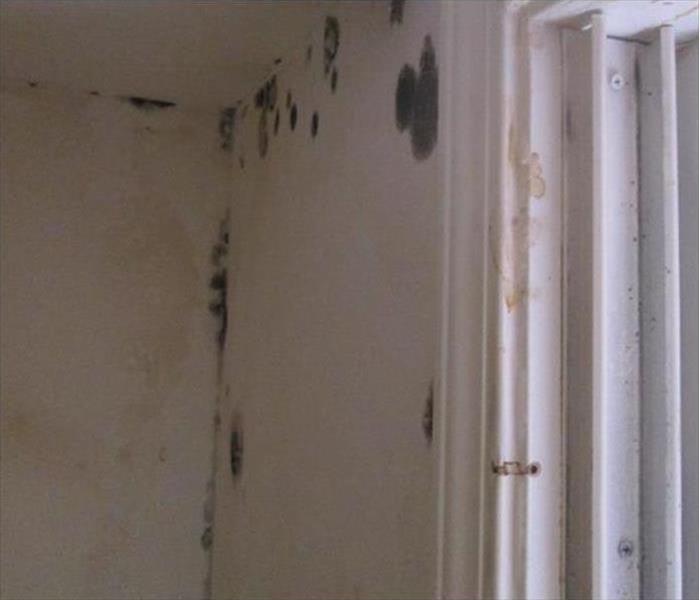 Black mold damage in a home in Los Gatos, CA.
Black mold damage in a home in Los Gatos, CA.
Top Reasons Why Your Mold Isn't Covered by Your Homeowners Insurance
You’ve kept your home in tip top condition but mold has still reared its ugly head. Fungus happens to even the most meticulous of homeowners, but fortunately you have mold coverage, right? This is an assumption that many Los Gatos, CA, homeowners have learned is incorrect only after being saddled with major bills. The truth is, with little exception, most homeowner’s insurance doesn’t cover fungus growth. Here are a couple of the top reasons why.
How costly is mold removal?
Getting rid of mold is no small task, and that’s one reason insurance companies are reticent to cover it. Repairs can run up to $6,000 and then some. That estimate includes things like:
- Inspections
- Air quality tests
- Remediation
- Restoration
If you’re expecting your homeowner’s insurance to pay for all of this, think again. Here’s why.
It’s Not a “Covered” Peril
On average, a homeowner’s policy pays for fungus growth damage caused by a “covered peril.” Such perils are events that are already covered in the policy, and typically include fire, lightning and vandalism – unlikely causes of mold!
You Caused the Damage
If mold resulted from something you did, your policy won’t cover it. Leaving around wet towels and other materials, resulting in a mold infestation is one example. Another is if a preventable water leak or other maintenance failures led mold to flourish.
It’s Flood-Related
A natural disaster like a flood might seem like a covered peril, and such events can indeed be covered, just not by a standard policy. Flood damage is typically covered by a flood policy separate and apart from typical homeowner’s insurance. That damage can include mold.
Knowing what your homeowner’s insurance will and won’t cover when it comes to fungus growth is key to being prepared. Speak to an insurance expert about mold insurance and mold remediation to learn how to get the protection you deserve.
 Even though the fire happened downstairs in the kitchen, soot and smoke filled the upstairs bedrooms.
Even though the fire happened downstairs in the kitchen, soot and smoke filled the upstairs bedrooms.






 24/7 Emergency Service
24/7 Emergency Service





































